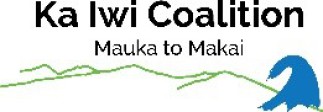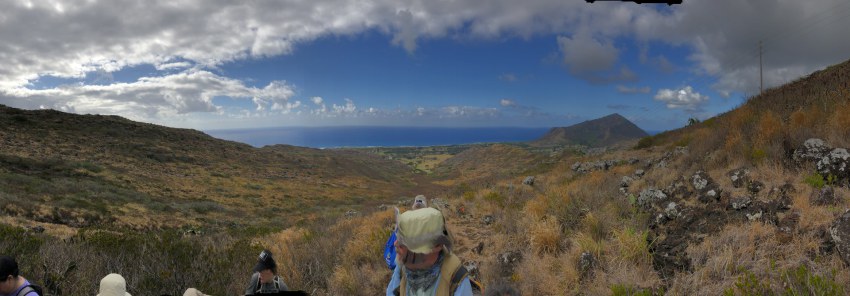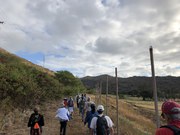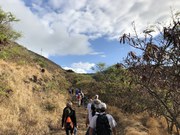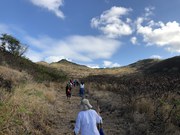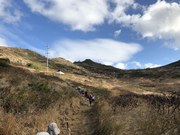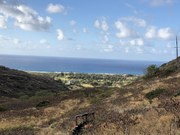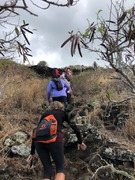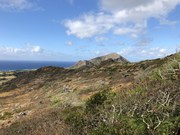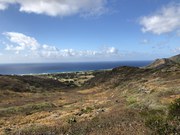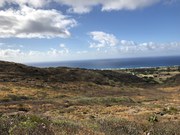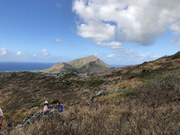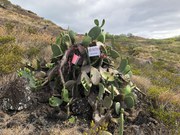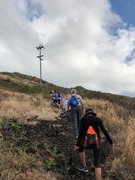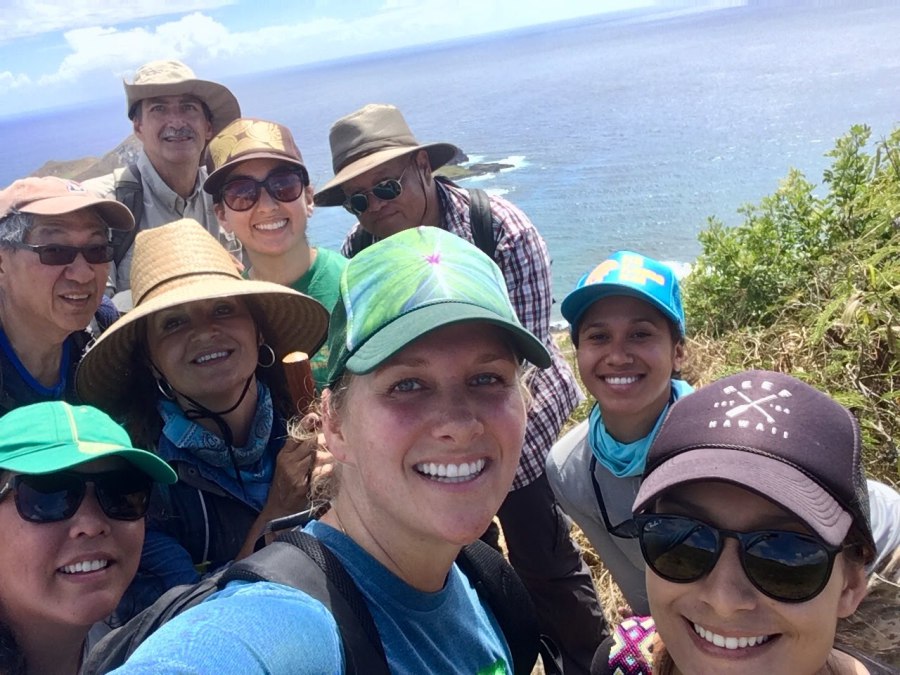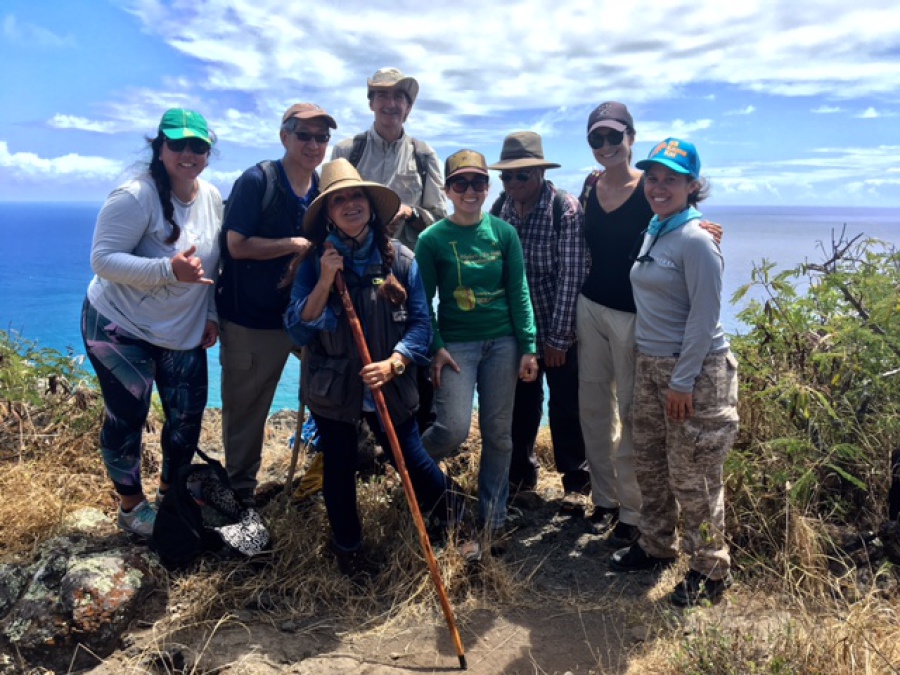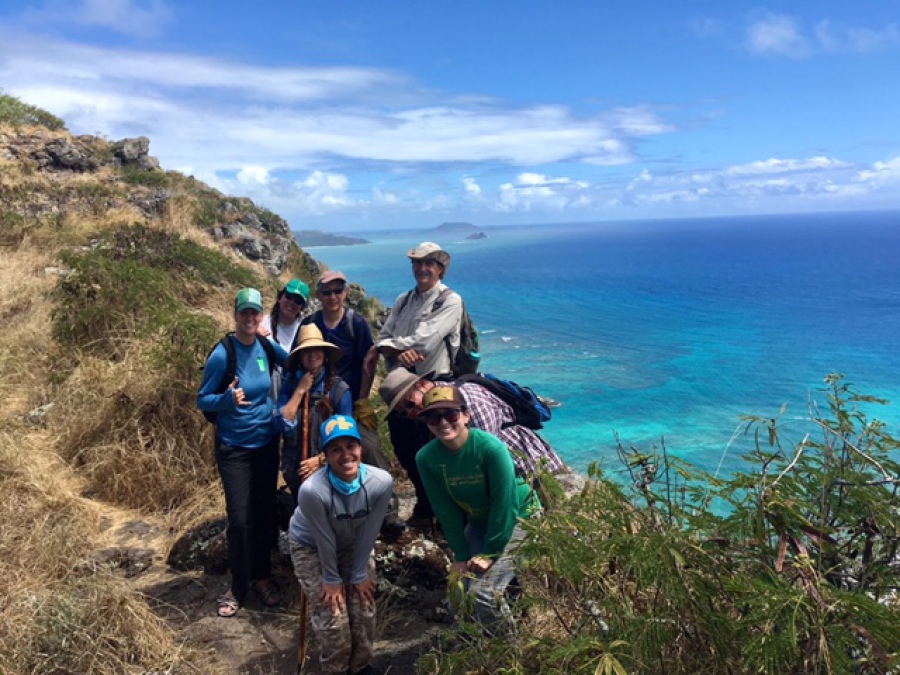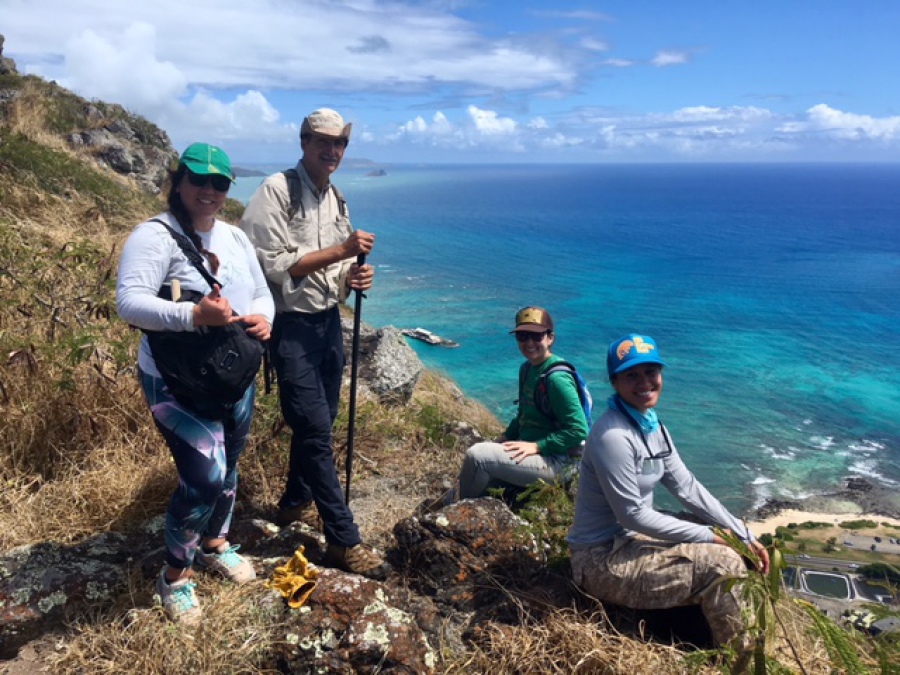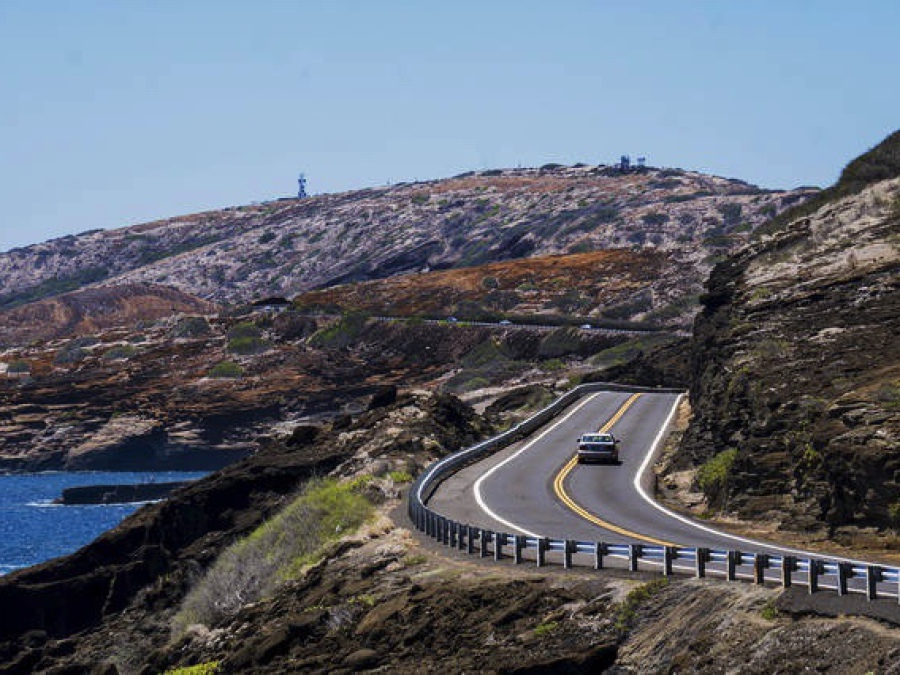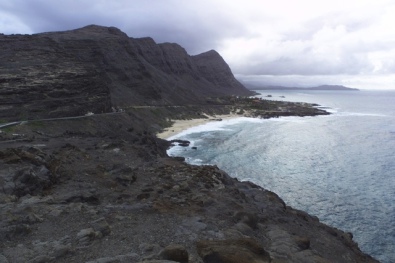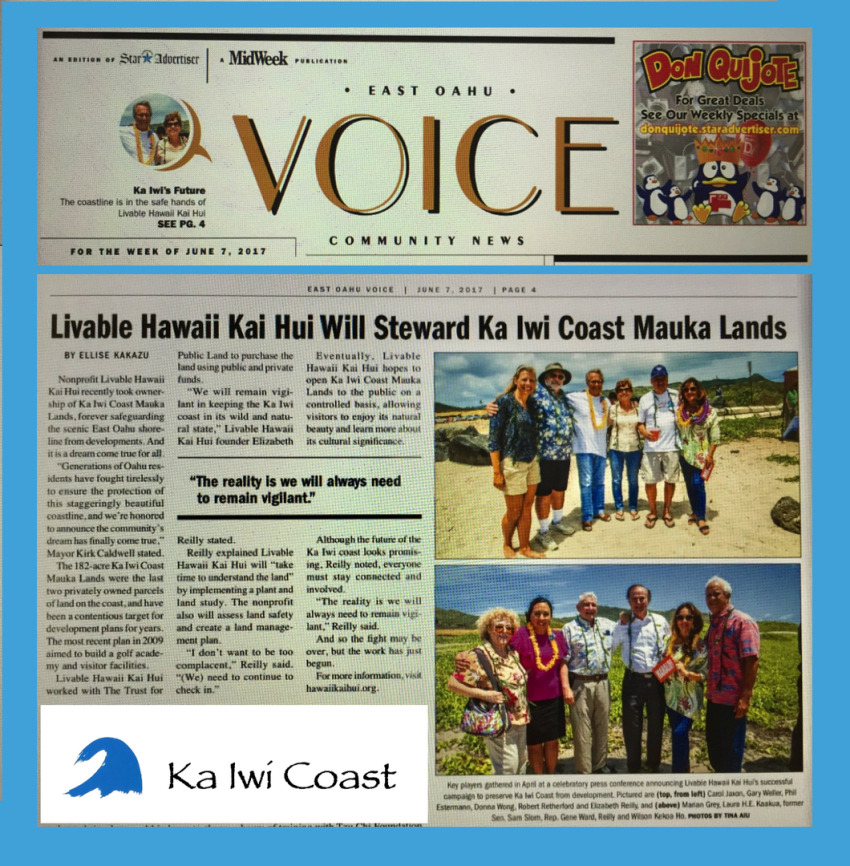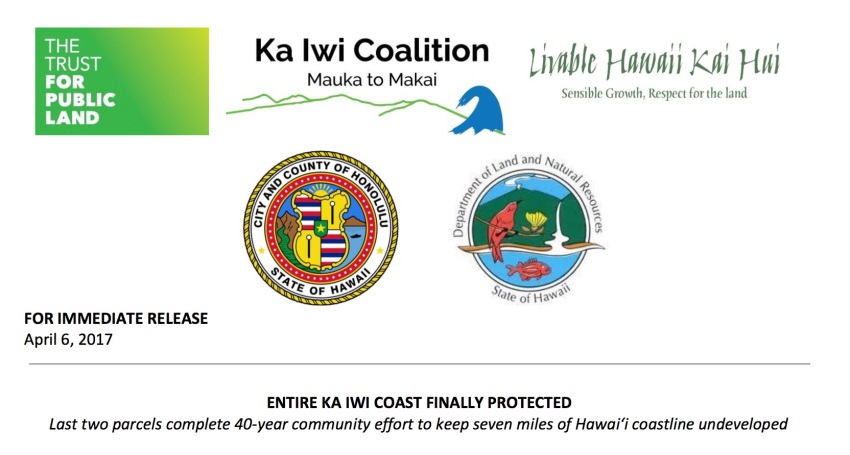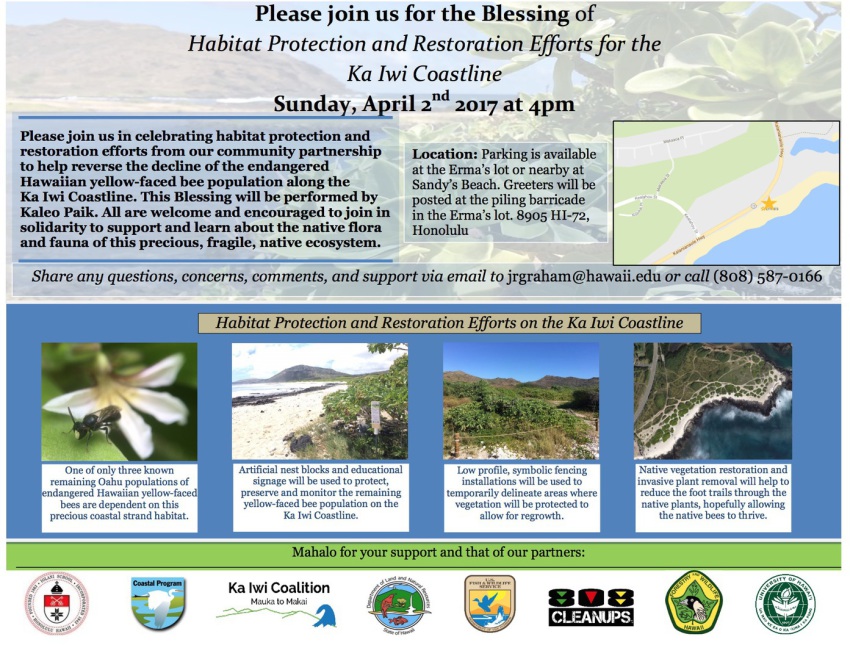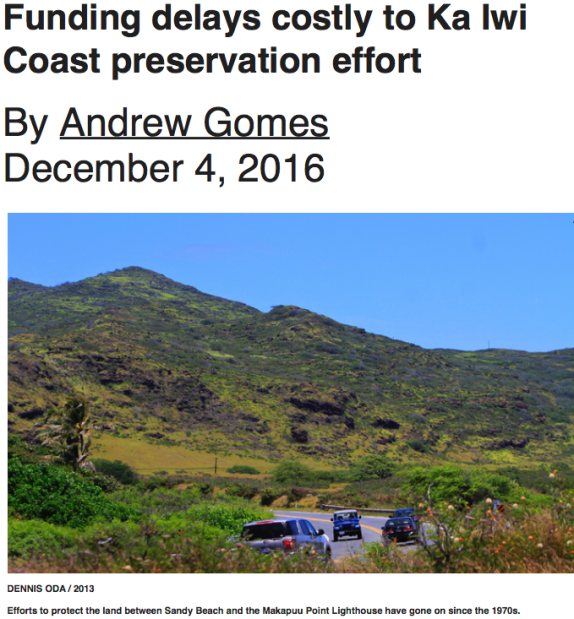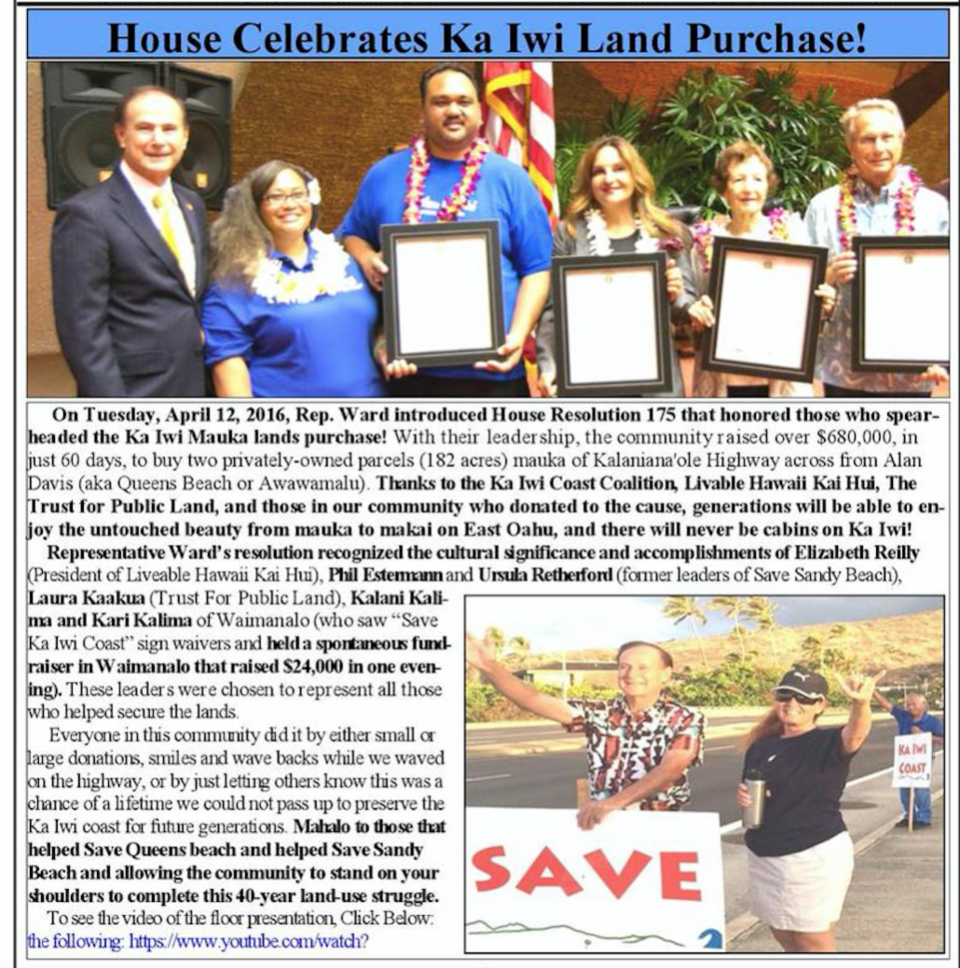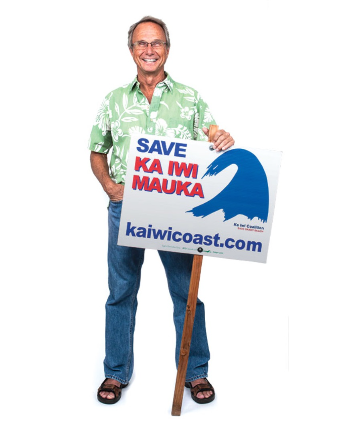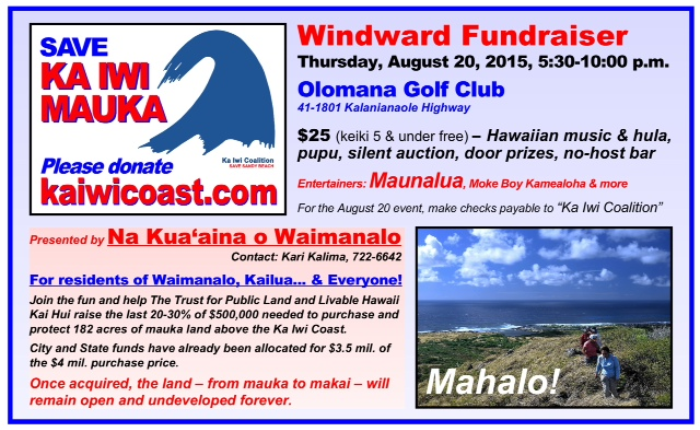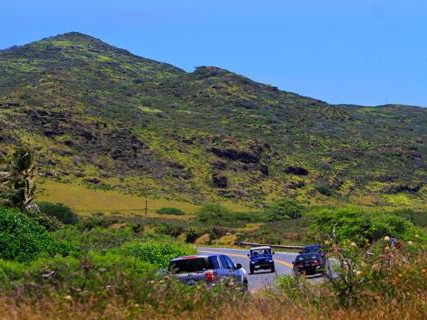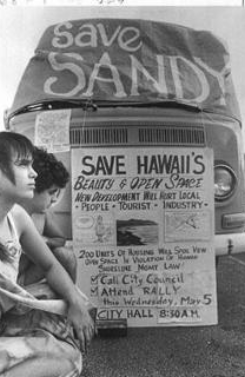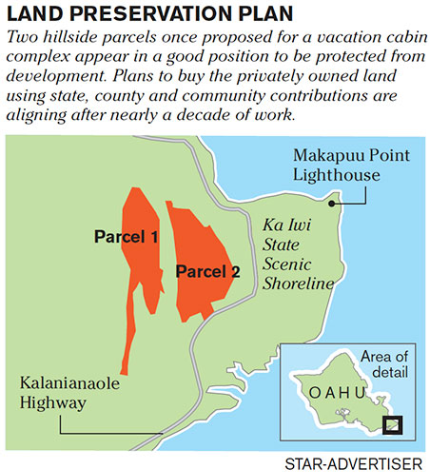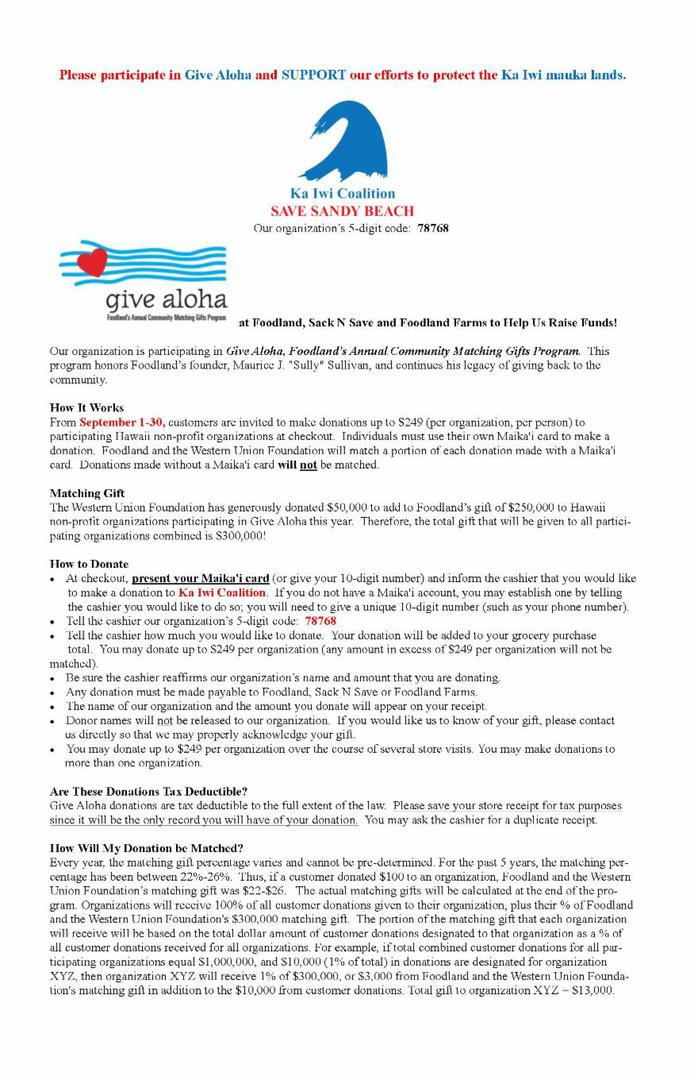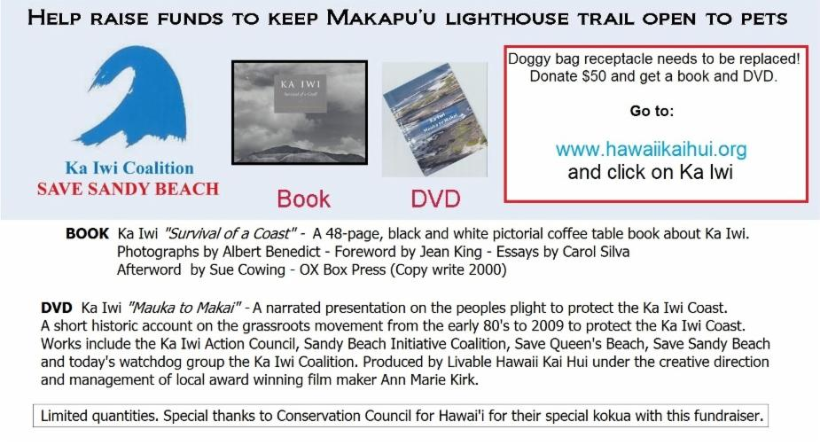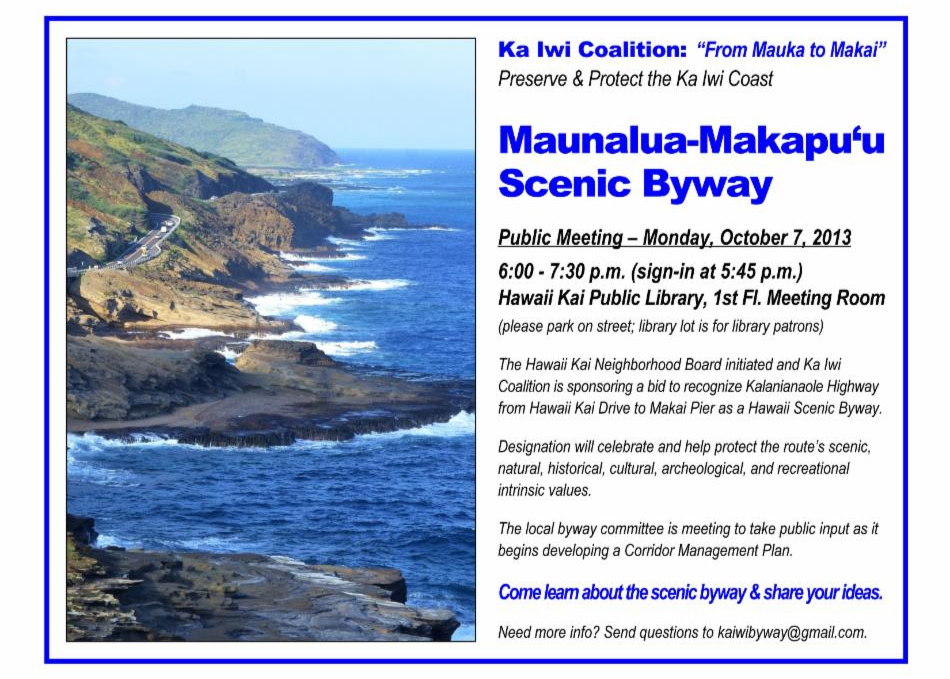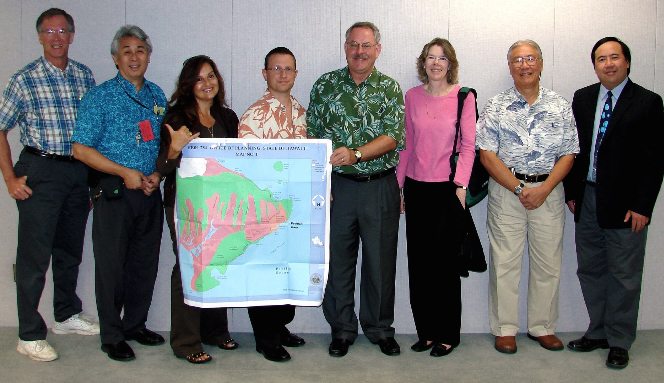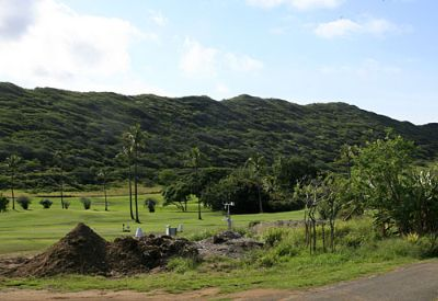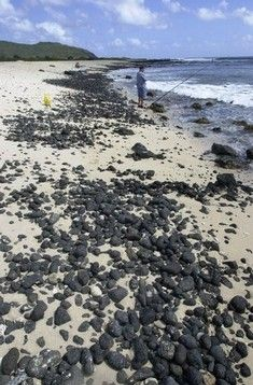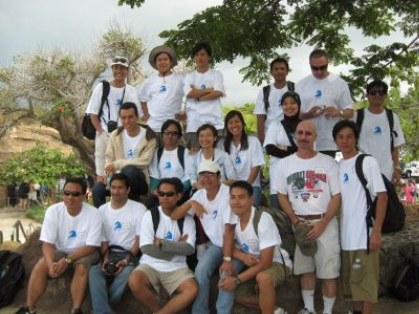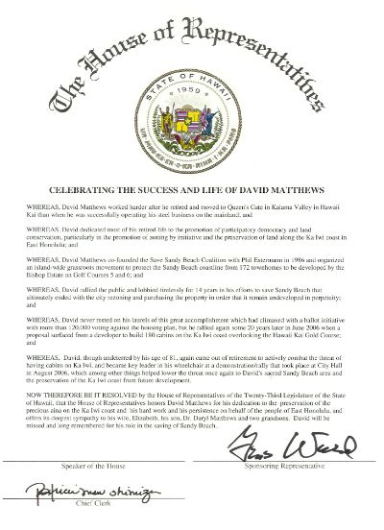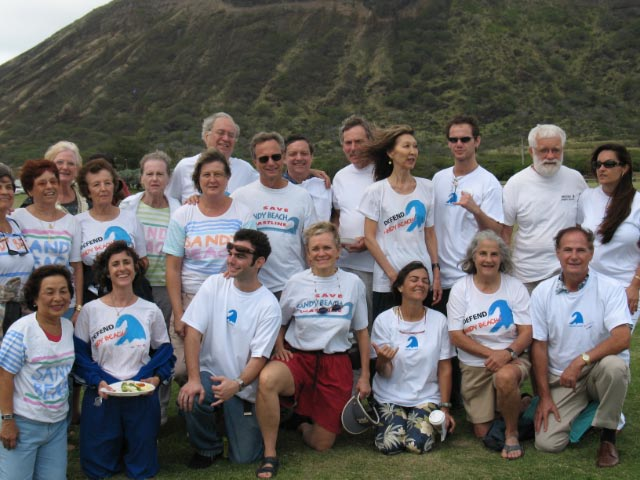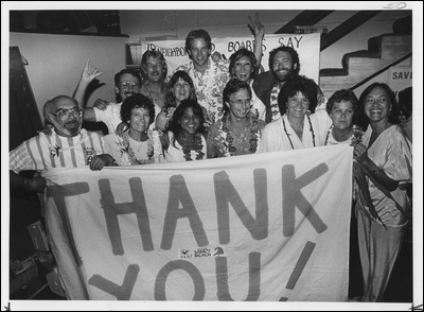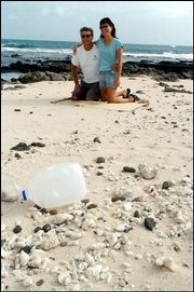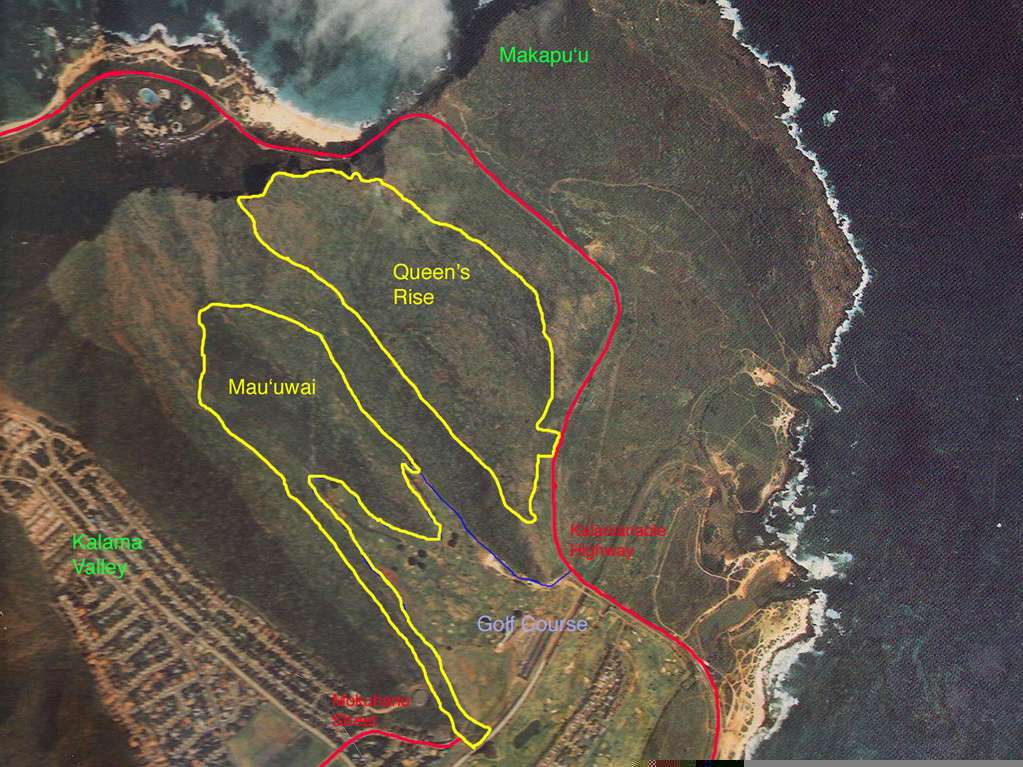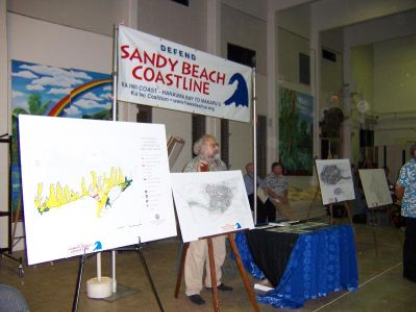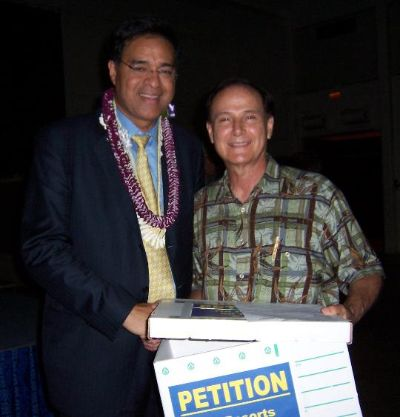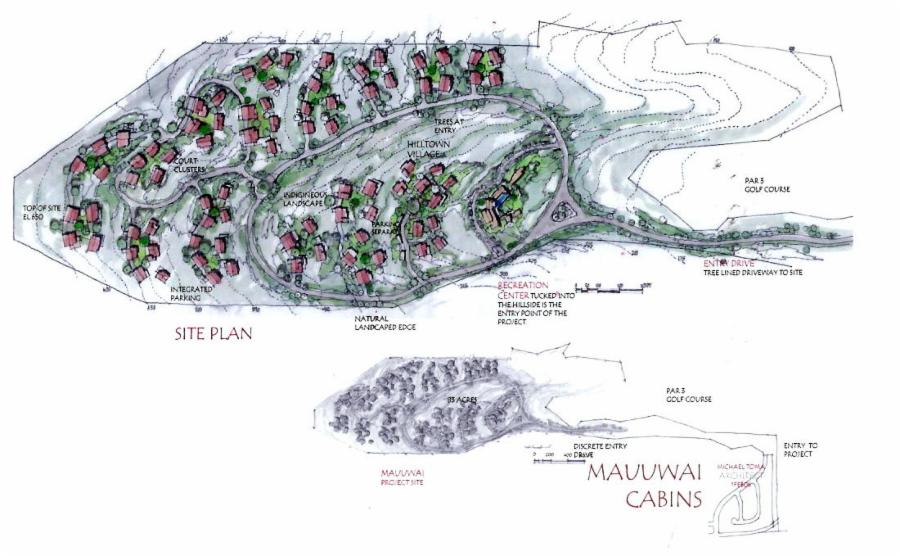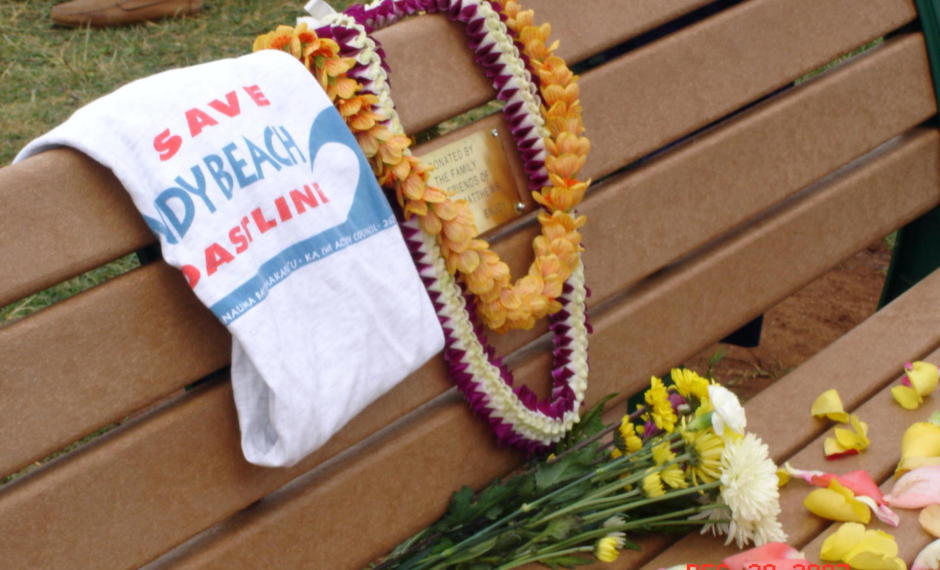
The Ka Iwi Coalition wants to celebrate the Ka Iwi Mauka community conservation success by launching Ka Iwi Explorations 2018. The event will feature guided hikes to learn about the natural and cultural resources of the area and plans for the future.
HERE ARE SOME PHOTOS FROM OUR AUGUST 5 AND 6TH HIKES.
A recent hike in June 2018 with our newest Ka Iwi Coalition 'ohana partners: The Trust for Public Land, Hui Nalu & Sierra Club Hawai'i.
11-1-17 The Maunalua-Makapuu State Scenic Byway plan is entering the final comment phase. The designation of this byway will help to protect and preserve the Ka Iwi area.
Livable Hawaii Kai Hui announced a lengthy management plan for changes at the Ka Iwi Scenic Byway for the public to download and comment (“Plan for Ka Iwi coast up for public review,” Star-Advertiser, Sept. 16).
Seeing nothing further, I have wondered (and hoped) that all who defended the beloved coastline so long and faithfully saw the announcement.
Mentioned for changes are docents at the lookouts, signage, tourist management, fencing and more.
To encourage all interested parties to be well informed to comment, I suggest the coalition release a list of sites and brief proposals and hold a public meeting.
Congratulations to the new wave of defenders who defeated the vacation cabins and preserved the land. The byway can be a wonderful achievement. As the Star-Advertiser said in its editorial Make long-term plans to protect Ka Iwi coast, Our View, Sept. 20): “Success hinges on careful planning that rejects any impulse to doll-up the byway with anything beyond basic improvements.”
Shirley Lum
Hawaii Kai
9-16-17 Star Advertiser.pdf
Adobe Acrobat document [88.8 KB]
Midweek Publications EAST OAHU VOICE - June 7th, 2017 - Ka Iwi Coast........http://midweek.com/pdf/East/2017/0607/index.html
TPL-HawaiiNewsRelease-KaIwiClosing-04041[...]
Adobe Acrobat document [293.9 KB]
• Community organization is paying more than it bargained for to protect 181 acres in East Honolulu overlooking the scenic Ka Iwi Coast due to a
holdup of financing from the city and state.
• The Trust for Public Land bought the property in March from a liquidated development firm for $3.65 million to prevent a competing buyer from acquiring the site once intended for
vacation cabin development.
• But the nonprofit, which obtained a loan for the purchase, had been counting on city and state land preservation programs that committed to provide $3.5 million for the deal
almost two years ago.
• So for the last nine months the trust has been stuck making interest payments on the loan — about $7,300 a month — while it waits for what it still hopes will be the city and
state contributions.
• “We are hopefully at the end of working through this issue,” Laura Kaakua, native lands project manager for the trust, told members of the Hawaii Kai Neighborhood Board last week.
Kaakua said she expects government attorneys are close to putting the delay issues to rest and will release the money to pay off the loan within the next few months.
• The state Department of Land and Natural Resources, which pledged $1 million through its Legacy Land Conservation Program, couldn’t say whether it believes a resolution is
possible, according to spokesman Dan Dennison.
• “DLNR is actively working with all the other parties to resolve the issues, and is prepared to rapidly complete its role in the transaction when consensus is reached,” he said in
an email.
• Ray Soon, chief of staff for Mayor Kirk Caldwell, said in a statement that the city is confident the issues will be resolved in a timely manner.
• “Mayor Caldwell strongly supports the preservation of the Ka Iwi lands and is pleased that the Trust for Public Lands already owns the property, meaning it can never be
developed,” he said.
• The holdup over the taxpayer money has to do with encumbrances, or restrictions, that prior owners of the property tied to the title of the land.
• The restrictions, Kaakua said, specify repercussions for not subdividing or developing the land. But Kaakua said her organization’s research, which was assisted by a historical
owner of the property, Kamehameha Schools, concluded that the encumbrances are unenforceable.
• “We have done a very thorough review and believe the restrictions have expired,” she said in an interview.
• The original plan was for the community nonprofit Livable Hawaii Kai Hui to purchase the property with the city and state funds, and then manage the land for educational public
uses and preservation.
• Livable Hawaii Kai raised more than $500,000 from the community last year to help with the purchase, which was expected to be more than $4 million based on the seller’s appraisal,
which turned out to be high.
• A lot of the money raised was spent on closing costs and the $150,000 shortfall between the sale price and what the city and state funds were supposed to cover. Since March,
though, money that would have gone to managing the land instead is paying mortgage interest.
• The city, according to Soon, made clear to the Trust for Public Land in March that it would withhold its funding until the title issues were resolved.
• Kaakua said the two nonprofits couldn’t delay the purchase because a backup buyer was ready to act if the nonprofits didn’t buy the property in
March.
• “We had to make a decision to take the risk and take out a loan to purchase the property,” she said. “This was a big risk, but it was absolutely worth it.”
• Kaakua said efforts by Livable Hawaii Kai and predecessor groups to protect the land known as Ka Iwi Mauka along with nearby shoreline parcels over prior decades convinced the
trust’s national board to go ahead with the loan.
• The older efforts, dating back to the 1970s, blocked developers from putting up hotels, condominiums and golf courses on oceanfront sites between Sandy Beach and the Makapuu
Lighthouse.
• The effort to develop Ka Iwi Mauka goes back a least a decade when a firm led by local developer Bob Gerell floated a plan to develop cabins on two parcels zoned for preservation
and owned by another development firm, Maunalua Associates.
• Gerell’s plan was to develop 180 vacation cabins under county zoning rules that allowed cabins as a secondary use to recreational activities. On-site recreation facilities in the
plan include a pool, tennis courts, volleyball courts and mountain biking trails.
• Public opposition that included a 3,000-signature petition erupted over the plan, and the city Department of Planning and Permitting rebuffed a permit application after concluding
that recreation activities appeared to be an accessory to the vacation cabins instead of the other way around.
• Gerell’s firm, QRM LLC, kept trying to obtain a permit and in 2008 offered to reduce its plan and give half the site to a willing organization for free. That same year, QRM bought
the land from Maunalua Associates for $3.6 million and resold it for $5.6 million to Kulia I Kanu‘u Estates LLC, an affiliate of Utah-based Management Solutions Inc.
• About two years later, Management Solutions was sued by the U.S. Securities and Exchange Commission, and a federal judge in Utah ruled in 2013 that the company improperly mixed
investor capital and spending on assets that were largely mainland apartment buildings roughly valued at $220 million.
• The federal court appointed a receiver to sell company assets to repay defrauded investors and creditors. Livable Hawaii Kai and the Trust for Public Land arranged the state and
city contributions and reached an agreement with the receiver, Gill Miller, to buy the property.
• Though the property is now in safe hands, the nonprofits want to move on to caring for the land instead of using the community’s money to service a loan.
• “We are almost there,” Kaakua said. “We are almost to the finish line.”
2015 November - Honolulu Magazine's Quote Unquote, featuring our own Phil Estermann! Ka Iwi Coast Coalition
A land purchase to keep more of East Honolulu’s Ka Iwi Coast as open space is expected to be finalized next month. Phil Estermann, 73, has been fighting development of the Ka Iwi shoreline since the ’80s. He’s worked in politics, in energy conservation and at the East-West Center. This latest plan to safeguard 182 acres of mauka lands is a joint effort of The Trust for Public Land and a grassroots community fundraising campaign that raised more than half-a-million dollars to cap city and state funding to reach the $4 million needed to complete the purchase.
MY WIFE AND I moved to Hawai‘i Kai in 1984. So I was here when Kaiser Development Co. tried to revive the Queen’s Beach project in 1985.
IT WASN’T UNTIL April 1987, the mammoth hearings, when a broad cross-section of the community testified against the housing project across from Sandy Beach.
TWO UNIONS CAME OUT against it. That was the ILWU and Local 5, along with people from all over the community, from all over the island, actually. I couldn’t remember a labor union ever opposing a development.
WE FILED A LAWSUIT the next month. Then we began to organize the initiative effort. We had about 10 weeks and we gathered 40,000 signatures of people who said they were registered voters.
IT RESULTED IN a resounding mandate in terms of the public’s affirmation of wanting open space: 249,000 voters voted and two-thirds of them voted for open space. Even more, we won in every district, and the stunning fact was we won in 181 of 183 precincts islandwide.
WE HAD WON one battle and lost another. The court invalidated the initiative in the spring of 1989. The City Council downzoned the property for development. But the public’s use of initiative and referendum had been taken away.
NOW, ONLY THE City Council or county councils can make land-use decisions.
THE STATE ULTIMATELY bought the Queen’s Beach property from Bishop Estate.
DEVELOPERS PROPOSED building vacation cabins on the slopes of the property, which we’re now in the process of buying. The community rose up and said, no way; they resoundingly rejected that plan. Then there was a golf proposal and the owner fell into bankruptcy.
GARY WELLER AND ELIZABETH REILLY of Livable Hawai‘i Kai worked with the Trust for Public Land’s Laura Kaakua. That’s how we got to this point, with their leadership and the leadership of Ann Marie Kirk.
IN JUNE, we set out to raise $500,000 and we raised $700,000. In a 10-week period, we raised an amazing amount of money.
I HAD NO IDEA 30 years later it would still be a significant part of my life. It’s extremely gratifying to see that the area is now considered permanently open space. And that we have a new generation of leaders who are carrying on the battle.
I’M MORE LIKE A senior adviser of some kind. A mentor of sorts. I appreciate that role now. It’s really great to see this whole thing move forward.
Did you know? The Trust for Public Land’s Laura Kaakua says the trust recently signed a purchase agreement for the mauka lands and hope to complete the transaction by the end of this year.
The Ka Iwi Coast Coalition exceeds land-purchase fundraising goal 10 days early
Adobe Acrobat document [365.2 KB]
Adobe Acrobat document [596.2 KB]
Adobe Acrobat document [1.1 MB]
Adobe Acrobat document [1.3 MB]
Adobe Acrobat document [572.7 KB]
Adobe Acrobat document [199.5 KB]
NOW MORE THAN EVER WE NEED YOUR DONATION
After decades of work by thousands, and the victory of the Save Sandy Beach initiative, the concern remains that development on the two privately-owned parcels (182 acres) mauka of Kalaniana'ole Highway across from Alan Davis (aka Queens Beach or Awawamalu), could destroy the magnificent view planes along Ka Iwi Coast. The once-in-a-lifetime opportunity to acquire these Ka Iwi Coast Mauka Lands puts the community on the verge of realizing its long-held dream of ensuring that the entire Ka Iwi Coast will remain in open space forever for all to enjoy. We have until August 30, 2015 to raise the remaining $500,000 needed for this $4,000,000 acquisition. Please join the island-wide community effort with a fully tax-deductible donation that will forever tie your legacy to an undeveloped Ka Iwi Coast.
A quote from: Ursula Retherford - "As a friend said, "Wow, this is BIG". After decades of work by so many concerned citizens, and the victory of the Sandy Beach Initiative, the worry remains that development, such as the 180 cabins planned a few years ago, on the two privately owned parcels (182 acres) across from Queens Beach could mar the magnificent view planes of this coastal area. Now the unique opportunity to acquire these two parcels puts us on the verge of realizing the long-held dream of ensuring that the entire Ka Iwi Coast will remain in open space for the enjoyment of all, residents and visitors alike, forever. I hope that all who cherish this natural, spiritual, cultural, as well as economic resource will be generous with tax-deductible donations to help meet the challenge of raising the needed $500,000 by August 30 to secure the purchase. Yes, this is BIG and unprecedented. I have faith that people will rise to the occasion. Each donation is a precious legacy and gift to present and future generations."
Please download the forms below to see Ka Iwi History, Ka Iwi Petition & 2011 Ka Iwi Brochure.
Adobe Acrobat document [1.1 MB]
Adobe Acrobat document [425.9 KB]
Adobe Acrobat document [555.9 KB]
7/25 - Supporters fight to keep East Oahu landscape from development http://www.hawaiinewsnow.com/story/29630523/supporters-fight-to-keep-east-oahu-landscape-from-development
Journal Ohana: Gary Weller, a Board Member of The Livable Hawaiʻi Kai Hui, has put together this compilation of various News Media releases on the Save Ka Iwi Coast Mauka to Makai endeavor.
http://www.hawaiinewsnow.com/story/29630523/supporters-fight-to-keep-east-oahu-landscape-from-development
https://support.tpl.org/events/save-ka-iwi-coast-mauka-to-makai/e51779
https://youtu.be/o0AM71qkWOg
http://www.bizjournals.com/pacific/news/2015/07/24/save-ka-iwi-coast-coalition-seeks-250k-more-by-aug.html
http://www.bizjournals.com/pacific/news/2015/07/06/oahus-save-ka-iwi-coast-coalition-gets-100k-boost.html
http://www.hawaiikaihui.org/6.html
http://honolulu.suntimes.com/hnl-business/7/100/103054/oahus-save-ka-iwi-coast-coalition-gets-100k-boost-from-former-ebay-exec
http://www.civilbeat.com/2015/07/youth-involvement-critical-in-saving-ka-iwi-coast/
http://www.kaiwicoastrun.org/community/
http://www.kitv.com/news/conservation-groups-closer-to-saving-2-ka-iwi-lots/28981700
http://www.kitv.com/news/conservation-groups-hoping-to-keep-ka-iwi-coast-as-is/28983616
Preservation near for Ka Iwi - The state is close to acquiring 181 acres along the coast after a long community battle - By Andrew Gomes
POSTED: 01:30 a.m. HST, Mar 22, 2015
An effort to remove development threats from a ridge top and valley overlooking East Oahu's scenic Ka Iwi Coast is finally coalescing after nearly a decade of arduous work.
State and city commissions have recommended tapping dedicated land preservation funds to pay most of the $4 million estimated cost to buy 181 acres once proposed for 180 vacation cabins, tennis and volleyball courts, pools and trails.
The acquisition is still subject to a few hurdles, including reaching final deal terms with the landowner and City Council approval.
Nonprofits leading the initiative also will have to raise an estimated $500,000 to $600,000.
But clearly the goal appears within grasp following years of effort opposing development and urging protection.
"It appears as if the stars are aligning for the completion of a movement -- a people's movement -- to protect a mauka-to-makai coastline," said Elizabeth Reilly, president of the nonprofit Liveable Hawaii Kai Hui.
For many East Oahu residents, protecting the area referred to as the Ka Iwi mauka lands represents an extension of a decades-long battle that protected coastal areas between Sandy Beach and the Makapuu Lighthouse.
The earlier fight sought to stop developers in the 1970s from adding hotels, golf courses and condominiums envisioned by industrialist Henry J. Kaiser to the coastal area on land owned by Kamehameha Schools.
A grass-roots champion of that fight was the Save Sandy Beach Coalition, which helped lead to city and state purchases of more than 300 acres after a long legal struggle.
The state bought about 300 acres of coastal land from Kamehameha Schools for $12.8 million in 2001 that became a designated state scenic shoreline for public use.
A costlier piece of the preservation effort stemmed from the city downzoning 32 acres of trust land across from Sandy Beach. The trust and developer Maunalua Associates sued the city for economic losses and prevailed. However, before a 2002 trial to determine damages, the city settled for $5.4 million in cash plus proceeds from the sale of city land in Manana. Years later the Manana land sales generated $86 million for the trust and developer.
Bob Retherford, a Kailua resident who was involved with Save Sandy Beach with his wife, Ursula, said protecting the Ka Iwi mauka lands would complete the community vision.
"The fact that it is being done is kind of like a dream come true," Retherford said. "People have worked a long time to preserve that coast."
The cabin proposal was floated in 2006 by QRM LLC, which was led by local developer Bob Gerell, on two parcels owned by Maunalua Associates and zoned for preservation.
One parcel covering 98 acres with views of the Hawaii Kai Golf Course, Makapuu Beach and the Ka Iwi Coast was dubbed the Queen's Rise Recreation Center. The other parcel, dubbed Mau'uwai Recreation Center, was slated for 83 acres extending up a valley partially occupied by the golf course.
QRM aimed to develop the project under county zoning rules that allow cabins as a secondary use to recreational activities.
"There is a demand for increased recreational opportunities for the growing population of East Honolulu," Aaron Eberhardt, a QRM representative, said at the time. "We recognize the community's concerns, and we've designed our projects to blend into the existing landscape and complement nearby Ka Iwi State Park and other surrounding recreational areas."
QRM's plan produced a big negative public reaction, though whether it was consistent with zoning rules was up to the director of the city Department of Planning and Permitting.
Reilly recalled that former Save Sandy Beach leaders sprang back into action and formed the Ka Iwi Coalition as an offshoot of Liveable Hawaii Kai Hui. Support to block the project was rallied, and a petition with about 3,000 signatures was sent to then-Mayor Mufi Hannemann.
At one community meeting attended by about 300 residents, Hannemann was urged to condemn the property. Hannemann expressed concern that the city couldn't afford such a purchase.
Later that year, DPP declined to process a permit for the cabin project after concluding that the plan failed to show that cabins would be an accessory use to outdoor recreation.
"As proposed, the outdoor recreation activities appear accessory to the vacation cabins," wrote Henry Eng, then-DPP director.
QRM had indicated that visitors staying in the 800-square-foot cabins could make arrangements for existing nearby activities that include golf, horseback riding, fishing, snorkeling, scuba diving, archery and hiking as well as new on-site activities including swimming, picnicking, tennis, volleyball, rock climbing, mountain biking and horseshoes.
DPP rejected amended permit applications two more times. In 2007, project opponents helped change the city's land-use ordinance so that cabins on preservation land would require a higher-level permit with a public hearing.
In 2008, bills were introduced in the Legislature to better protect the two parcels. One bill would have provided money to buy the land, while the other bill instructed the state Land Use Commission to reclassify the state land-use designation for the parcels from urban to conservation. Neither measure passed.
Before discussion of the bills began, QRM offered to limit its plan to just the 83-acre parcel abutting the golf course and give the other parcel to a willing organization for preservation.
"I think we've been very generous in what we've offered," Bill McCorriston, a local attorney representing QRM, said at the time, claiming the land was worth about $20 million. "It's unprecedented to offer somebody 100 acres in urban and East Oahu for nothing."
Still, community opposition remained stiff. At a Hawaii Kai Neighborhood Board meeting in early 2008 that drew a crowd of about 300, speakers said the scaled-back project wasn't acceptable.
In July 2008, QRM bought the two parcels for $3.6 million and simultaneously resold the land for $5.6 million to Kulia I Kanu'u Estates LLC, an affiliate of Utah-based Management Solutions Inc., which in 2009 discussed the possibility of developing a golf academy.
An unexpected shake-up with the property's ownership happened in 2011 and improved community efforts to protect the property.
The shake-up was triggered by a U.S. Securities and Exchange Commission lawsuit that alleged Management Solutions was a Ponzi scheme that defrauded investors, who were often recruited by company principals Wendell A. Jacobson and Allen R. Jacobson through their membership in the Church of Jesus Christ of Latter-day Saints.
Assets of Management Solutions, mostly made up of apartment buildings on the mainland roughly valued at $220 million, were frozen. A federal judge ruled in 2013 that financial irregularities existed in how investment money and expenses were shared between properties but that the operation didn't amount to a Ponzi scheme.
A court-appointed receiver, Gil Miller, has been liquidating the assets to repay defrauded investors and creditors, and is willing to sell the Ka Iwi property to the state in partnership with the Ka Iwi Coalition and the Trust for Public Land.
The preservation groups used an appraisal from the landowner to target a $4 million anticipated purchase price, and sought to obtain the bulk of the money needed from two local commissions that approved awards last year.
The state Legacy Land Conservation Commission approved $1 million. The city Clean Water and Natural Lands Commission approved $2.5 million.
On the state side, the Department of Land and Natural Resources has endorsed the purchase and would own the land if a sale is completed. An approval was expected from the Board of Land and Natural Resources earlier this month, but a decision was deferred to a subsequent meeting.
On the city side, the $2.5 million is included in the next fiscal-year budget but would still need to be approved by the City Council.
One member of the city commission noted in a report that the opportunity to acquire the Ka Iwi mauka parcels is imperative now since the receiver aims to sell the property.
"The threat of development will always be there as long as the property is held (privately)," the commissioner, who was not identified, said in the report.
"The Ka Iwi Coast means so much to the people of Oahu, who have worked long and hard to protect one of the last undeveloped coastlines on Oahu," said another commission member.
Reilly said if the state and city funding receives final approvals, private fundraising efforts would likely begin in the summer.
"We've been working for eight years on this opportunity," she said. "The struggles have been so intense, but it seems that it eventually works out to where the land stays in its natural state."
LHKH and DLNR Legacy Land Conservation Program Video - https://www.vimeo.com/106341736
December 2011 - Representative Gene Ward introduces Elizabeth Reilly to discuss Ka Iwi coastline
http://www.youtube.com/watch?v=5PeWXrfhw9k
Olelo Video - http://olelo.granicus.com/MediaPlayer.php?view_id=30&clip_id=19963
2-9-2011 - Here's a great article found at MidWeek.com Title: LWV Lauds Sandy Beach Coalition By: Guest Writer. After nearly 30 years of fighting to protect the precious swath of land along the Ka Iwi coastline, the Save
Sandy Beach/Ka Iwi Coalition is being honored for its efforts. To Read more please go to the following url: http://www.midweek.com/content/zones/east_coverstory_article/lwv_lauds_sandy_beach_coalition/
6-26-10 Sandy Beach Invitation (See PDF below)
Adobe Acrobat document [72.2 KB]
6-4-10 GOVERNOR LINGLE ANNOUNCES KA IWI SAVED FROM DEVELOPMENT![]()
HONOLULU – Governor Linda Lingle announced that the State Land Use Commission (LUC) today voted unanimously to reclassify the Ka Iwi Scenic Shoreline from urban to
conservation. The area encompasses approximately 215 acres of state-owned land on O‘ahu’s south-east coast between Queen’s Beach and the Makapu‘u Lighthouse. The reclassification by the LUC helps
ensure the preservation and conservation of the makai region of the pristine Ka Iwi Coast.
“The reclassification should make future development of this portion of the Ka Iwi Coast a remote possibility in keeping with the wishes of the East Honolulu and greater O‘ahu community,” said
Governor Lingle. “I applaud the many individuals and organizations throughout the community who have worked tirelessly and passionately to protect this pristine part of our state. In particular, I
want to thank Abbey Mayer of the Office of Planning for implementing this re-designation, as well as the Livable Hawai‘i Kai Hui and Representative Gene Ward for their initiation of this
process.”
The Hawai‘i Kai and Waimanalo communities have fought for decades to save the last open-space lands on the southern coast of O‘ahu from development, as land owners have changed and brought forth new
development proposals. The Department of Land and Natural Resources has improved the Makapu‘u Lighthouse trail and Makapu‘u Beach Overlook within the last several years to make this area more
accessible to nature lovers and hikers.
“This action ensures that the entire coastline, from Hanauma Bay to Makapu‘u will remain undeveloped well into the future,” said Mayer, director of the State Office of Planning, whose office filed
the petition for the reclassification in January 2009. “I have been honored to be able to play a role in preserving this legacy for generations to come.”
“This is a great day for East Honolulu,” said Rep. Ward. “In the beginning, we were told that such a reclassification couldn’t be done due to a lack of resources and time, plus it hadn’t been done
anywhere for more than a decade. But we all worked together as a community with the Governor’s office and now the preservation of the Ka Iwi coast has become a reality.”
The Governor noted the battle to preserve Ka Iwi for future generations is not over. The mauka area is not designated conservation, and the potential development of this land remains of paramount
concern to the community.
“My Administration will continue to work with the community to preserve this important part of what makes Hawai‘i so special,” the Governor said.
SLIDESHOW OF THIS EVENT Many thanks to all those who came out to support the preservation of the Ka Iwi Coast. Livable Hawaii Kai Hui's letter of Testimony and the initial Press release are also included in the slide show. April 22nd marks the 6th year anniversary for LHKH. Five of those years have been spent in active partnership with the Ka Iwi Coalition under the mentorship of Phil Esterman and the late Dave Matthe
Mahalo to Senator Hemmings for responding to our call over a year ago when we asked, "Why is Ka Iwi designated urban and how can we change it to conservation". We also
thank Shirley Lum, the Rutherfords and the 44 thousand petition signers of the 70's, 80's, and 90's grassroots movement save Sandy Beach and Beach and surrounding and select mauka land. 

We also thank Shirley Lum, the Rutherfords and the 44 thousand petition signers of the 70's, 80's, and 90's grassroots movement to Save Sandy Beach and surrounding makai and select mauka land.
4-7-10 - SANDY BEACH PRESS RELEASE
http://www.hawaiinewsnow.com/Global/story.asp?S=5337675
11-5-09 Protestors Rally Against Hawaii Kai Cabins Sasha Takeuchi Gene Ward Connect with us! by Beth Hillyer
HAWAII KAI (KHNL) There are concerns about whether the cabins will remain recreational or someday be turned into an oceanside resort.
Many in the community oppose vacation cabins along the pristine Ka Iwi coastline. Resident Sasha Takeuchi says, "Hawaii Kai is too overcrowded already."
Plans include large cabins and a recreation center is also on the drawing board.
Gene Ward comments, "Ka Iwi should remain in it's pristine state. Ka Iwi should remain in it's natural state."
Sasha worries if Kalanianaole highway can handle all the extra cars, "It is going to cause a lot of traffic there is only one lane going back and forth."
Sasha wants to keep this coastline as it is. "I think the people developing this are just looking to make a lot of money. I think it's not worth it to build over our preserve lands we should keep
preserve."
We were unable to reach the developers
The city has until Friday to act on their request for permits
__________________________________________________________________________________________________________
October 2009 - Ka Iwi Coast - Important news ! - This is to inform you that a petition to amend the State Land Use District Boundaries with the following informatioin has been submitted to the State Land Use Commission. Click the PDF below to see the file.
Adobe Acrobat document [103.8 KB]
July 2009 - Reso. 09-29,CD1 Urban to Conservation & Livable Hawaii Kai Hui Letter. (Click on the PDF below)
Adobe Acrobat document [159.8 KB]
Adobe Acrobat document [28.4 KB]

LATEST ON KA IWI http://www.starbulletin.com/business/20090428_On_deck.html?page=1&c=y
ON DECK - New owners propose a golf academy for a Hawaii Kai parcel - By Nina Wu
POSTED: 01:30 a.m. HST, Apr 28, 2009.
Nine months after purchasing the lands, a Utah-based investor is envisioning a golf academy above the Hawaii Kai Golf Course. The proposal is likely to spark another debate at this evening's Hawaii Kai Neighborhood Board meeting, where the public has weighed in on previous controversial development plans for the preservation-zoned parcels.
Management Solutions of Fountain Green, Utah, which formed Kulia i ka Nu'u Estates, acquired 83 acres in Mauuwai and 98 acres at Queen's Rise from QRM LLC in
July.
City property tax records show two transactions occurred in July, one at $5.6 million and another at $3.5 million.
Kirk Soares of Coldwell Banker Pacific Properties brokered the deal and represented the buyer.
Project manager Skip McWhorter, who was in Honolulu this week, said Kulia envisions building a complete golf academy, with classrooms and simulators for individual and group instruction for just the Mauuwai parcel, although size and details have yet to be ironed out.
McWhorter said he also was in discussions with possible pro golf sponsors for the academy.
"We would like to use the golf academy as a place to teach and train junior golfers," said McWhorter. "Our goal is to continue to promote the game of golf in Hawaii. We want to provide an opportunity that is fun, recreational and beneficial for locals and junior golfers all over the island."
At the same time, McWhorter said it would make sense for there to be accommodations, possibly vacation cabins, at the site for out-of-town golfers.
"If we don't have that there, we're left with people commuting back and forth from Waikiki," he said.
The two parcels are Management Solutions' first investment on Oahu, according to partner Allen Jacobson, from Utah. Jacobson said the company did 14 months of due diligence and has no plans for Queen's Rise at this time.
Permitted uses on P2 general preservation lands such as Mauuwai include cemeteries, outdoor recreational facilities and vacation cabins as an accessory to those outdoor facilities, according to city Planning and Permitting Director David Tanoue.
Vacation cabins would require a major conditional-use permit subject to a public hearing.
The developers are currently meeting with individuals and small groups to talk about the project, said McWhorter, and won't be applying for permits for several months.
A Web site is under construction.
Though no permits have been filed yet, the concept of a golf academy and vacation cabins already has some opposition.
"I don't think a resort destination has a place within the Kalama Valley residential community," said neighborhood board member Elizabeth Reilly, who is with the nonprofit Livable Hawaii Kai Hui. "Resort destinations belong out in Waikiki and Ko Olina."
Paradise for Sale: $1
By Sara Yacuk, 2/2/2009 9:55:32 AM
At 75 years old, I would have preferred not to have to fight any battles, but when I learned the State plans to commercialize the Pali Lookout and Ka Iwi Park to
accommodate visitors so to collect a fee, I told my grandson it is time to put on the war paint.
Shame on the Department of Land and Natural Resources for peddling paradise for $1 and further weakening Hawaii's gracious aloha spirit. But more importantly is this action promotes segregation
between us, local people and them, the visitor.
We need to strike Ka Iwi and the Pali Lookout from the DLNR's hit list well buried within the glossy title of the state's "Recreational Renaissance."
The overall plan has merit but got sloppy towards end when it took the 'status quo' route to commercialize two important landmarks.
Today's Diamond Park complete with information center, T-shirt sales, non stop huge buses of tourists and two florescent lit soda vending machines are changes not to be proud of - this is not proper
care of special places and very inconsiderate to future generations.
I can only hope our Legislators see the writing on wall: "Paradise for Sale for $1" - Vistitors Keep Right, Locals Stay Left"
Please join me in the protest to stop this madness. Email DLNR at: mailto:Laura.Thielen@hawaii.gov or get involved with an area grassroots group like Ka Iwi Coalition at http://wwww.hawaiikaihui.com
Sara Yacuk is a resident of Hawaii Kai
KHNL NEWS COVERAGE http://www.khnl.com/global/story.asp?s=9737173
January 29, 2009
Letters to the Editor
Ka Iwi
Work continues to protect mauka side
Many thanks for the Ka Iwi coverage (Jan. 26). All the exposure Ka Iwi can get would be great, as there is more work to done on the mauka side.
No doubt the state's action inspires and empowers the community to continue the necessary work to protect the mauka side of Ka Iwi as well as ensure the entire area is kept in its natural
state.
Future conversation we intend to ignite includes exploring a partnership to protect the mauka side of Ka Iwi. We hope to bring to the table the O'ahu Land Trust, The Trust for Public Land, State of
Hawai'i, City and County of Honolulu, the community and a willing land owner.
I also wanted to point out that it was Sen. Fred Hemmings who worked on this over the holiday season with (state Office of Planning director) Abbey Mayer.
Many thanks again.
Elizabeth Reilly | Ka Iwi Coalition / Livable Hawai'i Kai Hui
Advertiser's Opinion
Posted on: Thursday, January 29, 2009
Let future generations enjoy Ka Iwi's beauty.
The long struggle to preserve the scenic Ka Iwi shoreline has received a strong, much-needed boost.The Lingle administration wants to reclassify about 240 acres of
land on O'ahu's southern coast, from Queen's Beach to the Makapu'u Lighthouse, from urban to conservation.
Once the state Land Use Commission completes the lengthy process which includes public hearings and possible environmental review, the new classification will make it much more difficult to build on
this lovely, rugged stretch of coastline.
That's more than an environmental victory. It's a gift for future generations of O'ahu residents and visitors.
Residents, area lawmakers and environmentalists have fought for more than 30 years to keep golf courses, hotels and housing away from this unspoiled stretch of land.
But the issue isn't entirely settled. Nearby, two parcels of privately owned land mauka of Kalaniana'ole Highway remain open to development.
An attempt to build "vacation cabins" permitted under the city's zoning rules was thwarted last year. Ownership of the parcels has changed, but the possibility for development remains.
The best solution would be a mutual agreement among government, the community and the landowners to keep the parcels in their natural state for today, tomorrow and generations to come.
Lingle wants Ka Iwi coast free of development - Posted on: Monday, January 26, 2009
Lingle wants Ka Iwi coast free of development / State land-use panel being asked to change shore's urban zoning
By Suzanne Roig - Advertiser Staff Writer
Gov. Linda Lingle is paving the way for the final step in preserving the most accessible wild coastline on O'ahu for generations to come by asking the state Land Use
Commission to reclassify the Ka Iwi shoreline from urban to conservation.The 400 acres, now under state jurisdiction for the Ka Iwi Scenic Shoreline, is on the makai side of Kalaniana'ole Highway
from Queen's Beach to Makapu'u. While the area is used for recreation in its natural state, unless its land classification is changed to conservation, it will not be safe from development.
The area has been the battleground for three decades as community groups fended off bids for hotels, golf course developments and housing. In November, the Hawai'i Kai Neighborhood Board heard its
first presentation from the state on what the land classification means. A second meeting will be at 7 p.m. tomorrow at the Haha'ione Elementary School cafeteria.
"If the land remains classified as urban, there will always be the threat of development to this unique scenic beach and open-space treasure," Lingle said in a prepared statement.
"The community has worked to protect this area for future generations, and the action my administration is taking will support their efforts by helping to prevent any further development
proposals."
The land, while zoned preservation by the county, has a state designation of urban, which could leave room for rezoning and development. In 2006, the state completed a $5 million improvement plan
created with Ka Iwi Action Coalition support that placed utility lines underground, created a clearly marked trail to the Makapu'u lighthouse, placed parking inside the park and barred off-road
vehicles from driving in the shoreline park areas.
The community praised the governor's efforts. At a time when a proposal to build vacation cabins on the land mauka of the Ka Iwi Scenic Shoreline is still being considered by developers, the
community is looking at ways to make sure the land remains undeveloped, said Greg Knudsen, Hawai'i Kai Neighborhood Board chairman.
"It is a further step in the protection of those lands," Knudsen said. "The reclassification makes the state and county designations more consistent. The community could then be assured that the
intent of the area will remain undeveloped."
Elizabeth Reilly, a member of the Neighborhood Board and founder of the Livable Hawai'i Kai Hui, a grassroots group formed to ensure growth and change is in compliance with the county's East Honolulu
Sustainable Community Plan, said the community has tried to remain vigilant over the area ever since developers made their plans known, in 2007, to build 180 cabins on two parcels: one in a valley
behind the Hawai'i Kai Golf Course and on land across from the entrance to the Makapu'u Lighthouse trail.
"The state is finishing a job that started 30 years ago by the will of the people," Reilly said. "By changing the designation on the makai side, it will send a message to land owners on the mauka
side that this is an important natural resource and there is a movement to protect it."
Reach Suzanne Roig at sroig@honoluluadvertiser.com.
MAY 2008
We thought you would enjoy this photo - notice their T-shirts! The photo is from the May 23, 2008 field study session on the history and cultural significance of the Ka Iwi Coastline preservation movement for the East-West Center's Ford Foundation International Fellowships Program.. Whereas this year's effort to secure a basic commitment from the state via SB2248 to stimulate partnerships to protect mauka sections of Kai Iwi from continued pressures of development failed, we are confident a solution exists and will continue to explore all options.
KA IWI COAST VIDEO ON YOU TUBE: Links are below: these links may no longer be available
http://youtube.com/watch?v=o0AM71qkWOg
http://www.youtube.com/watch?v=2EcieqXmW4U
Video of Jan. 8th meeting with William McCorriston below: the 2 links below were removed.
http://olelo.granicus.com/MediaPlayer.php?view_id=11&clip_id=1306&publish_id=&event_i
Minutes: http://www.honolulu.gov/nco/nb1/08/01200801SpecMin.PDF
3-07-08 Article from PACIFIC BUSINESS NEWS (Click the PDF below for the article)
Adobe Acrobat document [40.1 KB]
Video Links to News Coverage by KHNL and KGMB9
http://www.khnl.com/global/story.asp?s=7794652
http://kgmb9.com/main/content/view/3680/40/
Saving Ka Iwi Coast Doesn't Have to Cost Taxpayers a Bundle
There is a push to use state taxpayer funds to purchase “preservation” land on the Ka Iwi Coast line fronting Sandy Beach.
See the full bill here: http://www.capitol.hawaii.gov/session2008/Bills/SB2248_.pdf
Testimony on the bill will be heard Saturday, Feb. 9, 2008, at 11 a.m. in Conference Room 229.
The environmental group, Hawaii Kai Hui, says this is an “amazing opportunity” because it will “protect and perpetuate the aina and its cultural resources for the benefit of future generations; Ka
Iwi is the last open and accessible coastline except for Kaena Point; East Oahu has lost more green open spaces to development than any other part of the island; the 7 mile Ka Iwi coast drive
supports the visitor experience to the East end of Oahu; preserving will enable all our residents, tourists and future generations to enjoy this pristine area; the Ka Iwi area is an irreplaceable
natural, scenic resource for the state of Hawaii; the Ka Iwi scenic shoreline has rich cultural significance, some documented and some yet to be discovered.”
There is no doubt that the Ka Iwi Coast line should be preserved. It was decided years ago that the land should remain undeveloped and it was thereby designated “preservation” by the
government.
The real question is why is this even up for discussion? The Ka Iwi coast line is considered “preservation” land and preservation should mean preservation, not some open space with a lot of fancy
hotel rooms that are being called “cabins” by sneaky developers to try to bypass legal requirements.
Rather than using taxpayer money to buy the land at a premium, the state Legislature should amend the law so that “preservation” truly protects property from being developed when it is not supposed
to be. That would protect Ka Iwi and other precious preservation land around the state.
- Malia Zimmerman
http://www.eastoahusun.com/community-news/2008/2/1/few-in-favor-of-ka-iwi-development.html
January 30, 2008 - KA IWI CABIN PLAN VOTED DOWN, 13-0
http://www.honoluluadvertiser.com/apps/pbcs.dll/article?AID=/20080130/NEWS01/801300416/1190/NEWS01
By Eloise Aguiar
Advertiser Staff Writer
HAWAI'I KAI — The Hawai'i Kai Neighborhood Board last night voted to reaffirm its stance against development in the Ka Iwi area, as residents again voiced opposition to a
plan to build vacation cabins. --- The board voted 13-0 at the meeting at Haha'ione Elementary School. --- The board's action is an expression of community sentiment but carries no
regulatory power. ---Develop QRM LLC still needs approvals from the city Department of Planning and Permitting before it can build. --- State lawmakers have also introduced bills to preserve the area
through rezoning or land acquisition. --- QRM wants to build 180 cabins on two parcels: one in a valley behind the Hawai'i Kai Golf Course and on land across from the entrance to the Makapu'u
Lighthouse trail. --- On Jan. 8, QRM offered to scale back its plan to build on 181 acres and build on only the 83-acre parcel, called Manu'uwai, near the golf course. --- About 300 people attended
the board meeting and speaker after speaker rejected the project and the scaled-back proposal. --- Area resident Charlotte White reminded people that the issue wasn't limited to Hawai'i Kai, but was
a statewide issue. --- "I think what we all want to say in unison is we don't want this project," White said. "It's not cabins. It's a resort and we don't want it. Let's go on record one time. The
answer is no." --- The room responded with a loud "no" and a round of applause. --- Others, like Paul Paaaina, commented about saving a place where they grew up, fishing, picking limu and playing.
Such a development would take away one of the last open shorelines on O'ahu, said Paaaina, who came from Nanakuli to testify. --- "There's gotta come a time to say enough is enough," he said. ---
Gregg Stueber said he, too, grew up in the community and has seen many changes, some good, some not. What has remained unchanged is the coastline, Stueber said. --- "Some of these things need to stay
the same," he said. --- William McCorriston, attorney for the developer, spoke before the board voted and said he was pretty sure about the outcome and he admonished the panel for
not being realistic in seeking a solution. --- "I understand this is an emotional issue with the community," McCorriston said. "And I have a fair understanding of what the vote will be here tonight
but you also should be realistic ... You're not going to get something for nothing. If you really want to work toward solutions, you can't just say no. --- "State Rep. Gene Ward, R-17th (Kalama
Valley, Queen's Gate, Hawai'i Kai), who has drafted bills to stop the project from moving forward, said the board's vote reaffirmed the resolve in the community." ---
The neighborhood board rejected the resort (developer's effort to) get a toe hold in the community," Ward said.
JANUARY 29, 2008 - Honolulu Advertiser Article by Suzanne Roig.
Bills in Legislature aim to protect Ka Iwi Coast
http://www.honoluluadvertiser.com/apps/pbcs.dll/article?AID=/20080129/NEWS01/801290354
1-18-08 an update from Rep. Ward's Office - UPDATE ON KA IWI CABINS PROPOSALS: NOT A LOT OF GOOD NEWS AFTER TWO MEETINGS
"Buy me out, or let me build, or I'll take you to court."
Due to the confusion created by missed communications between the developer's attorney and the neighborhood board and a 60-day rule, the Hawaii Kai Neighborhood Board was
forced to call an emergency meeting on January 8, 2008 instead of the normal meeting scheduled for January 29th to hear about the cabins proposals on the Ka Iwi Coast.
The meeting started off with a briefing and a sour note by William McCorriston, lawyer and spokesman for QRM LLC, who said upfront, "The cabins are not located on Ka
Iwi, if so, Aina Haina is also on the coast." While his definition was quickly disputed his ensuring comments cut to the chase: "QRM does not intend to go away," suggesting this was going to be a
long and protracted affair. The options? "You either buy out my client, or let him build the cabins, or we'll sue you and keep this in court," is the best summary and paraphrase of the gist of the
entire meeting. Before adjourning about 9:10 PM. McCorriston had also offered a new proposal: in exchange for the community's approval of the cabins development, 98 acres of the land at "Queen's
Rise" (or 50% of the development project) would be dedicated to the City and County of Honolulu or to a selected not-for-profit organization. No one seemed impressed.
Following the Hawaii Kai Neighborhood Board meeting, I invited some elected officials and members of our community to meet with Mr. McCorriston at my Capitol office about statements he made in the
emergency meeting. The meeting was held on the Opening Day of the 2008 Legislature, January 16th and Ka Iwi became the first official business of the office at 2 PM.
In particular Mr. McCorriston was asked if what he presented to the board was to be interpreted to be the "actual" plans for cabins, or just "conceptual" plans as they were often referred to by him
in the meeting. He was also asked about owners' identities; how the plan could be approved by DPP this time if it is the same as last time when the cabins were not considered to be "accessory" to
recreational use; the increased traffic on Mokuhano Street, etc, but just about no new information was forthcoming, except for the fact that the valley rather than the ridge behind the Hawaii Kai
Golf Course ("Mauuwai") would be utilized. Another new piece of information was that he would not be continually re-submitting the proposals to DPP (Dept of Planning and Permitting – City and County
of Honolulu) if the second application doesn't pass but would be likely taking the litigious route thereafter.
Bottom line of both meetings: Mr. McCorriston shed no new light on the subject but was able to repeat the basic options of "buy out", "build," or "lawsuit" to our community.
My sense from these two meetings was that the Hawaii Kai community must stay the course in its opposition to the proposed 180 cabins on Ka Iwi and not be intimidated by his legal threats, including
the claim that the City & County Department of Planning and Permitting did not treat his client fairly and possibly acted illegally in their denial of the cabins permit the last time
around.
In short, the problem with the law suit-approach used by McCorriston is that I believe the Hawaii Kai Community is not easily intimidated, and we also know the difference between the term "cabin" and
the 800 square foot hotel-condo clustered rooms located next to a swimming pool and a 4,000 square feet lodge that QRM is proposing.
Where do we go from here? The Hawaii Kai Neighborhood Board is due to take up the matter and outline its objections to the project in their next scheduled meeting on Tuesday, January
29th at 7 PM at Hahaione Elementary School. The public is invited.
East Honolulu senators and representatives are also meeting and planning an action strategy to combat the cabins at the State level, and I have personally briefed Governor Lingle on this matter and
she has voiced her concerns to me.
1-10-2008 - Reject proposal for vacation ‘cabins’ above Hawaii Kai
http://starbulletin.com/2008/01/10/editorial/editorial01.html
1-9-2008 - Hawaii residents protest proposed cabins
http://the.honoluluadvertiser.com/article/2008/Jan/09/ln/hawaii801090393.html
1/9/2008 - ‘No’ to vacation cabin plan - Residents reject the proposal for vacation cabins in Hawaii Kai.
http://starbulletin.com/2008/01/09/news/story04.html
ONCE AGAIN WE MUST TAKE ACTION TO - DEFEND OUR KA IWI COASTLINE
On December 30, 2007 family, friends, and residents gathered at Sandy Beach for the dedication of a new bench in memory of the late Dave Mathews. The bench looks out over the Ka Iwi Coastline and is a reminder of Dave's efforts to fight developement of this natural untouched coastline. Dave Mathews was founder of the Ka Iwi Coalition and organized a grassroots movement that continues today. He inspired many of us to get involved in our community. It is never too late to start!
Posted on: Wednesday, December 12, 2007 - Ka Iwi project revived
A developer apparently intends to resurrect a controversial plan to build vacation cabins on 181 acres of land near the Ka Iwi shoreline that failed to receive city approval last year.A Nov. 9 letter to the Hawai'i Kai Neighborhood Board from William McCorriston, attorney for QRM Inc., says that the developer is "considering submitting" an application for a permit needed for the cabins.

Neighborhood board members said they only received the notice Monday evening."I hardly slept last night thinking about this," said Gary Weller, chair of the board's subcommittee on planning and zoning.Weller said he and others are frustrated because they have not been able to put a face to QRM since news of the plan resurfaced. The company is no longer working through Westwood Development Group, which presented the initial proposal before a standing-room-only crowd at a Hawai'i Kai Neighborhood Board meeting last year.Neither McCorriston nor QRM could be reached for comment yesterday.The letter requested a meeting with the neighborhood board "within 60 days" of the request, but as the board has adjourned for December, members hope that the presentation can be pushed to February."We're looking for some clarity," said Elizabeth Reilly, a neighborhood board member. "It would be good not to start off (the new year) with such an important issue behind the eight-ball from the community's perspective."In September 2006, QRM's proposal to build 180 800-square-foot cabins along the Ka Iwi Coast was never processed by the Department of Planning and Permitting on the grounds that it was incomplete and had failed to prove that the cabins would be an accessory use to outdoor recreation in the area.The project was planned for two parcels of land, one above Hawai'i Kai Golf Course and the other mauka of Kalaniana'ole Highway, across from the entrance to the Makapu'u Lighthouse hiking trail. A 7,500-square-foot recreation center also was proposed.Both areas are zoned for preservation, meaning vacation cabins can be constructed only if they are shown to be a secondary use to outdoor recreation.It was unclear yesterday whether any or all of the original aspects of the plan would be included in the new proposal, which will face additional requirements this time around.In February, the Planning Commission approved amendments to the land-use ordinance relating to vacation cabins and indoor amusement and recreation facilities islandwide. This time around, the project will be reviewed for a conditional-use permit major, which requires the applicant to appear before the neighborhood board and undergo a public hearing process before the Department of Planning and Permitting considers it, city Planning Director Henry Eng said yesterday.No public review process was required when QRM applied for a permit last year, although presentations were made before the neighborhood board. The decision ultimately was left up to the planning director.Passage of the amendments was due in part to aggressive lobbying by community groups from across O'ahu, including Save Sandy Beach and Livable Hawaii Kai Hui, both of which protested the Ka Iwi development."I have faith in the process that we have in place, particularly because of the trigger for community involvement," said Reilly, who was active with Livable Hawaii Kai Hui in pressing for the amendments.Others, however, are gearing up for another scuffle.Yesterday, Weller was digging through piles of old files and rushing to compose an e-mail to rally the same community groups that were involved last time."We pretty much stopped because we thought it had ended," he said. "We shouldn't have been that naive, though."
By Kim Fassler - Advertiser Staff Writer
April 22nd, 2007 - Earth Week 2007 ended on a beautiful day with an organized effort by Representative Ward and his Community Liason Pam Kam. They met with the community to clean up the Ka Iwi Beach Area. Thank you to Livable Hawaii Kai Hui supporters and DLNR for helping out.
Proposed Cabins on Ka Iwi Shoreline near Makapu'u - AS OF FEBRUARY 2007
2-7-07 Here is some great news! Remember the plight of the proposed Ka Iwi Vacation Cabins? Feb. 7th, 2007 the Planning Commission unanimously approved the requested amendments to the Land Use Ordinance (LUO) relating to vacation cabins and indoor amusement and recreation facilities island-wide. What does this mean to you? It means a guarantee for community input via the public hearing process if and when vacation cabins and indoor amusement and recreation facilities are proposed in the P-2 General Preservation District. Because there were no requirements for public hearings the community experienced tremendous chaos in just trying to 'get the facts' on what was proposed for the Ka Iwi Coast! It was a crazy time that we would not wish on any other community! So born of our misfortune comes some upgrades to the LUO which adds the ingredient called "community" to the recipe of development for said uses.
A big Mahalo to YOU for YOUR support and to the following key players: Honolulu City Council with special acknowledgment to Councilmember Charles Djou, Representative Gene Ward, Representative Lyla Berg, The Dept .of Planning and Permitting, The Planning Commission, Ka Iwi Coalition. Cheers to all! Elizabeth Reilly - Livable Hawaii Kai Hui www.hawaiikaihui@aol.com Additional information on these amendments are available upon request.
Newspaper Articles are listed below: Please scroll down.......

State to give Makapu'u roadway $10M facelift
By Suzanne Roig
Advertiser East Honolulu Writer
Posted on: Sunday, January 14, 2007 http://the.honoluluadvertiser.com/article/2007/Jan/14/ln/FP701140379.html
Posted on: Monday, January 1, 2007 - //the.honoluluadvertiser.com/article/2007/Jan/01/ln/FP701010332.html
David Matthews, far left, helped organize the Save Sandy Beach Coalition that began in a 1986 dispute over Kamehameha Schools' plan to build 172 townhomes across from Sandy Beach. The islandwide grassroots movement ultimately ended with the city purchasing and rezoning the land to halt development.
David Matthews, who helped launch the movement to stop development across from Sandy Beach, died Saturday. He was 81.In an interview last January, Matthews talked about
his accomplishments, including his involvement in the state Democratic Party and several service groups around town."My clock is running down now and I have trouble day to day," Matthews said "But I
still keep busy. I help with the Hawai'i Kai Hui" — a group concerned with land use in that community.First Circuit Judge Michael Wilson described Matthews as larger than life."He was the kind of guy
who created inspiration," Wilson said yesterday. "He was a rough person who had the social (conscience) gene. He was an extremely loving guy who had an amazing capacity to love people in a real human
level."Matthews and his wife, Elizabeth, retired to Hawai'i in 1984, after he was diagnosed with lung disease.He loved his adopted home and organized the Save Sandy Beach Coalition with Phil
Estermann to protect the shoreline. But he wanted to make sure that he would be remembered not just as the man who blocked development, but for reading to kids at Palolo Elementary School with his
dog, Shaina, and his work with the East Honolulu Rotary Club.Before his illness became acute, he could be seen in his "poor man's Cadillac" — a dark blue Buick — around town going to city
Transportation Commission meetings, neighborhood board meetings and to the Palolo school.At the time of the Sandy Beach dispute in 1986, Kamehameha Schools owned the land on either side of Kealahou
Street and planned to build 172 townhomes on what was called Golf Course 5 and 6. But Matthews and others organized an islandwide grassroots movement that ultimately ended with the city rezoning and
purchasing the land to ensure that it wasn't developed.Shirley Lum, a Hawai'i Kai resident who worked with Matthews and Estermann, said: "We were comrades in arms. I saw him as the lion. He never
gave up. He was a vociferous defender of open space at Sandy Beach and Queen's Beach."His work with the Save Sandy Beach Coalition began while he was a member of Save Queen's Beach, which was working
to block a plan to build hotels and condominiums in the area commonly called Alan Davis Beach, below the Makapu'u Lighthouse hiking trail.The Save Sandy Beach Coalition organized supporters who
attended marathon City Council hearings that lasted well into the night to urge the council to rezone the land. The group backed a ballot initiative where more than 120,000 people voted against the
housing plan.Matthews spent years lobbying lawmakers to allow zoning by public initiative and worked behind the scenes for an organization called the Hawai'i Democratic Movement, whose stated goal
was to put more liberal politicians in office.Estermann said: "David's hallmarks were his commitment and persistence. When our energies flagged, or other demands on our time caused our attentions to
waiver, we could always rely on David to keep us focused on the goal."Hawai'i Kai Hui founder Elizabeth Reilly said Matthews' legacy extends well beyond the Save Sandy Beach movement."It will
continue to be the driving force behind protecting the natural environment of the irreplaceable Ka Iwi Coast in perpetuity. The heart and soul of what David taught us is best summed up in his
favorite thought-provoking quote: 'If we lose the beauty of the shoreline ... we lose what it means to live in Hawai'i.' "Matthews was born in Canada on Feb. 12, 1925. He grew up in Cleveland, but
didn't graduate with his high school class in 1943 because he volunteered to join the U.S. Army. He served three years as a military policeman, based in England. He eventually became a successful
businessman in Cleveland and formed his own company called Jade-Sterling Steel Co.After retiring to Honolulu in 1984, he sailed and traveled throughout Europe and Asia."I traveled a lot. I had a lot
of fun in life," he said. "I've done a lot with my life. The Save Sandy Beach Coalition was the best, the most satisfying and rewarding."I swell every time I drive to the coastline, especially when I
see what the state is doing with the Ka Iwi improvements."He is survived by his wife; son, Dr. Daryl Matthews, who lives in Hawai'i; and two grandsons. Services are private. A celebration of
Matthews' life will be at 11 a.m. Thursday at Sandy Beach.Reach Suzanne Roig at sroig@honoluluadvertiser.com.

Tuesday, December 12, 2006 http://the.honoluluadvertiser.com/article/2006/Dec/12/ln/FP612120344.htm
Litter plagues East O'ahu beach
By Suzanne Roig
Advertiser East Honolulu Writer HAWAI'I KAI — Over a period of seven days, Greg Schmidt collected 10 pounds of glass shards from a 10-by-50 foot patch of
sand at Alan Davis Beach.The Hawai'i Kai resident collected the glass — in hues of brown and green — not for its beauty, but to reclaim a patch of trash-free sand for his grandchild. Still, Schmidt
said, the trash keeps coming, along with other concerns.City crews often haul out lumber construction debris used as fuel in beach area fire pits, which can be large enough to swallow small dogs. And
some visitors apparently use vehicles to move heavy concrete barricades, making way for off-road rides."We spent about 30 minutes or so just picking up the broken glass and trash that litters the
beach in a space that's about 500 square feet — enough to put out some chairs or beach mats," Schmidt said. "People are just not taking care of the beach. They talk about preserving the natural
beauty of the area, but here they're just tossing their trash."As part of a wilderness area, there are no lifeguards or comfort stations or regular groundskeepers in the beach area, which is why it's
an area attractive to rubbish dumpers and others, said Alan Hong, Hanauma Bay manager, who maintains beach parks from Sandy Beach to Wailupe."It's a never-ending job," Hong said of the litter cleanup
effort. "People dump stuff there every day."Just last week a set of iron stairs and an air-conditioning unit were dumped at the far end of Sandy Beach, near the Ka Iwi area, Hong said. It took three
crew groundskeepers to lift the stairway into a truck, which transported the junk to the city dump."It's an unimproved area without a caretaker," Hong said. "It's a convenient place for people to
dump trash."He added: "Most people are aware of litter. The people dumping trash aren't less aware of the concern for litter. It's not that they don't know any better. It's out of laziness and a
disrespect for the land."In response to the call of Schmidt and others to heighten awareness about beach conditions, Rep. Gene Ward, R-17th (Hawai'i Kai, Kalama Valley), is studying the problem and
attempting to pinpoint which agencies or government offices are in charge of enforcing anti-litter laws and rules intended to keep cars off the beach."We don't want a wild country area, or a police
state," Ward said. "Somewhere in between is where we need to be. Keeping our beaches clean is a bigger issue than any one government office. It's a communitywide awareness issue."Schmidt wants people
to appreciate the beauty of the wind-swept grasses and open space."Look at the view," Schmidt said. "It's so beautiful, and why not preserve it? Each time I come here, I spend 20 to 30 minutes
cleaning up glass. No matter how much I pick up, it keeps coming back."Waimanalo resident Ray Makaila drives by the area regularly and also sees the ebb and flow of trash. While not a frequent user
of this part of Sandy Beach, Makaila said the problem stems from people — young and old — not appreciating the value of the land."It's a shame," Makaila said. "It's a people problem."Reach Suzanne
Roig at sroig@honoluluadvertiser.com.
Posted on: Saturday, December 9, 2006
Letters to the Editor
DEVELOPERS MUST HEED GOV. LINGLE'S SPEECH
Gov. Linda Lingle's inaugural address regarding de-emphasis on land development for the sake of human development as a new paradigm for Hawai'i future makes a lot of sense. I hope Hawai'i's
developers take it seriously.
It's a call for innovation and creativity. It is not a call to stop making money but to challenge developers and those with investment capital to start thinking outside the real estate box to other
ventures that interface with our future in the Asia-Pacific region.
A case in point might be the misplaced emphasis by developers in East Honolulu to build 180 cabins on the Ka Iwi coastline. There would be greater long-run returns to the developer and the state if
these funds were re-thought out in terms of the Lingle paradigm. As noted in her address, Hawai'i can be a model for other nations as well as the Mainland if we commit to develop our rich and diverse
human resource pool, natural energy resources, and entrepreneurial talents.
I don't believe we can achieve these at our present rate of mediocrity. We need new thinking, new projects, new local-international partnerships, new local businesses and new ways of seeing and
relating with Asia, especially on how to better catch the waves of the global economy in our region.
Gene Ward
Representative-elect, Hawai'i Kai, Kalama Valley
Sept. 20, 2006

9-12-06 Letters to the Editor
LAND USE - KA IWI CABIN PERMIT APPLICATION INCOMPLETE
We appreciate the thoughtful analysis of issues related to the recently returned application to build an outdoor recreation facility with vacation cabins at Ka Iwi
under a conditional use permit application (Editorial, Sept. 7).
We wish to clarify some of the terms used. As director, I found the application to be incomplete and inadequate. I, therefore, declined to process it.
Since the proposed use is listed in the P-2 General Preservation District in our Land Use Ordinance (LUO), by law I am required to accept an application for processing when it is complete. Acceptance
means that it has met the requirements for application. It does not mean approval.
An accepted application must be analyzed and a decision made — to approve, approve with conditions or to deny based on criteria outlined in the LUO.
Henry Eng
Director, City Department of Planning and Permitting

Wednesday, September 6, 2006
Ka Iwi permit denial gets OK from residents
Accessory use of cabins cited in city's rejection of permit - http://starbulletin.com/2006/09/06/news/story03.htm by Diane Leone
Wednesday, September 6, 2006
City says no
to 180 vacation cabins near Ka Iwi Shoreline
 The city rejected a
developer's permit application to build vacation cabins on 181 acres across from Ka Iwi Shoreline, a project that drew opposition from Hawai'i Kai to Kailua.
The city rejected a
developer's permit application to build vacation cabins on 181 acres across from Ka Iwi Shoreline, a project that drew opposition from Hawai'i Kai to Kailua.
Honolulu developer QRM was told that its plans were incomplete and failed to prove that the cabins would be an accessory use to outdoor recreation on the site, according to Henry Eng, director of the Department of Planning and Permitting.
"As proposed, the outdoor recreation activities appear accessory to the vacation cabins," Eng wrote in a letter Friday to QRM. "The outdoor recreational activities must be provided on-site as a principal use and must be clearly identified on the site plan.
"The company was told it may resubmit its application if city concerns are addressed, Eng said.
QRM could not be reached for comment yesterday. An official with landowner Maunalua Associates Inc., of Walnut Creek, Calif., said he could not comment on the city's action. Maunalua President Rick Stephens said he is not involved in development plans, and that he had a copy of Eng's letter but had not reviewed it.
QRM in June announced its intention to build 180 cabins on two pieces of land, one above the Hawai'i Kai Golf Course and the other mauka of Kalaniana'ole Highway, across from the entrance to the hiking trail to Makapu'u Lighthouse. The 800-square-foot cabins would be grouped in clusters, with construction of a 7,500-square-foot recreation center where guests could make arrangements for "nearby golf, horseback riding, fishing, snorkeling, scuba diving, archery, hiking excursions to Makapu'u Lighthouse and the nature areas around the Mau'uwai Recreation Center.
"Plans also touted outdoor swimming, picnicking, tennis, volleyball, hiking, rock climbing, mountain biking, horseshoes and team sport facilities on-site.
Access to the 83-acre Mau'uwai parcel above the golf course would be via Mokuhanu Street in Kalama Valley, and to the 98-acre Queen's Rise section via Kalaniana'ole Highway.
Both parcels are zoned for preservation, which allows vacation cabins if they are shown to be a secondary use to outdoor recreation. The purpose of preservation zoning is to manage major open spaces and recreation and scenic lands, according to the city's land-use laws.
QRM's proposal met with objection at a June meeting of the Hawai'i Kai Neighborhood Board, and a month later at a town hall meeting with Mayor Mufi Hannemann. Since that June meeting, the Hawai'i Kai, Waimanalo and Kailua neighborhood boards all have opposed the developer's plans.
Residents yesterday cautiously hailed the city's decision to reject the application for a conditional-use permit, but understood that the developer may resubmit the plans.
"The city's decision to protect the coastline gives me new hope," said Gayle Carr of Hawai'i Kai. "After years of frustration, seeing Hawai'i Kai's open spaces chiseled away and countless trips to City Hall to testify, I now feel rewarded that it was not all in vain. The city does listen.
"QRM's failure to identify mitigation measures to address community concerns raised at the June neighborhood board meeting was cited in the city's rejection notice. The developer also failed to prove that it had obtained a lease of at least five years from Maunalua Associates, the letter said, and did not provide others details such as target market, number of occupants per cabin, estimated length of stay for visitors and overall operations.
In addition, the application did not explain how the project complies with preservation zoning standards, according to the letter.
Elizabeth Reilly, founder of the Hawai'i Kai Hui, a grass-roots community watchdog group, questioned why the city's land-use laws require just a conditional-use permit, with no public hearings, for development on land that people believe is meant to be preserved.
"Whereas we are pleased that the city has not accepted the developer's application, we are concerned with what the city and state plan to do to preserve the Ka Iwi coast in perpetuity," Reilly said.
The Ka Iwi Shoreline, purchased with the help of federal money, is a state park preserve that runs from Sandy Beach to Makapu'u Lighthouse.
Reach Suzanne Roig at sroig@honoluluadvertiser.com.

Sunday, September 3, 2006 by: Chuck Prentiss
Chuck Prentiss is a retired urban planner with over 30 years experience.
He is a former executive secretary of the Honolulu City Planning Commission.
 All
preservation land is not created equal ...The proposal to build recreation cabins at Ka Iwi is based on a misinterpretation of the city's land use regulations. A PRELIMINARY
proposal for an extensive vacation cabin development in the scenic open space area near the Ka Iwi coastline of East Honolulu has caused quite a stir. A large parcel, zoned P-2 General Preservation,
is proposed for as many as 180 vacation cabins and related service facilities. Not since residential development was proposed for the land overlooking Sandy Beach has there been such a ground swell
of opposition to a proposed East Honolulu development.
All
preservation land is not created equal ...The proposal to build recreation cabins at Ka Iwi is based on a misinterpretation of the city's land use regulations. A PRELIMINARY
proposal for an extensive vacation cabin development in the scenic open space area near the Ka Iwi coastline of East Honolulu has caused quite a stir. A large parcel, zoned P-2 General Preservation,
is proposed for as many as 180 vacation cabins and related service facilities. Not since residential development was proposed for the land overlooking Sandy Beach has there been such a ground swell
of opposition to a proposed East Honolulu development.
How can this development be proposed in a preservation area? Well, it appears someone has mistakenly interpreted that this development is permitted by provisions of the City and County Land Use
Ordinance (LUO) because the P-2 zoning district permits one vacation cabin overall for each acre of land. (The cabins must be accessory to an outdoor recreation facility, and must be incidental to,
and customarily found in conjunction with the type of recreational facility. Buildings cannot cover more than 5 percent of the zoning lot).
The mistake in the interpretation is clear if one reads the purpose and intent section of the Preservation Districts in the LUO. It states: "The purpose of the preservation districts is to preserve
and manage major open space and recreational lands and lands of scenic and other natural resource value." So while there is land in the P-2 district because it has recreational value, not all the
land is there for that reason. Some is included because it has major open space value. There is also land in the P-2 district for its scenic value, or because it has other natural resource value.
This is where the interpretation runs afoul of the ordinance. Any interpretation that all land in the P-2 district is permitted to have recreational uses would violate the district's intent.
The important point is that all lands are not in the P-2 district for the same reason. Certainly not all are there because they have recreational value where vacation cabins may be appropriate. Land
that has been placed in the P-2 district because it has scenic or open space value cannot be "preserved and managed" by building tourist cabins on it. Can we preserve Diamond Head by building cabins
on its slopes?
Furthermore, the LUO in Section 21-3.40 says that it is the intent that lands designated urban by the state (as is the subject property), but well-suited to the functions of providing visual relief
and contrast to the city's built environment ... be zoned P-2 ... This is another provision that indicates all P-2 lands are not designated for active recreational use. In addition, other uses are
permitted in the P-2 district that are not suitable for all P-2 lands. These include agriculture, forestry, game preserves, grazing and resource extraction. Imagine resource extraction in a scenic
resource area, or agriculture on pali slopes!
A decision on the appropriate use for any specific property zoned P-2 must logically, and according to the intent of the LUO, be based upon the reason the property is in the P-2 district. Otherwise
the ordinance is violated, not to mention common sense. For the site under discussion, the proposed development would certainly destroy rather than "preserve and manage" a scenic, open space
area.

Vol. 11, Issue 241 - Tuesday, August 29, 2006
Letters to the Editor
P-2 Zoning should mean no development, period !
The city zoned the area from Ka Iwi Point to Sandy Beach P-2 to protect the land from hotel/residential development. The city should adhere to the designation that took more than 30 years to achieve. Preservation land should remain just that.
At the Hawaii Kai Neighborhood Board meeting in June, Westwood Development Group, also known as Moanalua Properties, presented a plan to build 180 cabins on the hillside near the state park. This
resort-like development is not appropriate for preservation land. Vacation cabins were intended to be an ancillary use to recreation. The developer in this case is proposing "vacation cabins"
(actually houses) and then planning to add recreational facilities to justify them. This subverts the intent of the ordinance, truly the tail waging the dog!
It also sets a terrible precedent. How many mountainsides on Oahu could be converted to resorts if this use of P-2 land is allowed? If the developer's interpretation of the P-2 designation is deemed
to be correct, then the ordinance needs immediate change to clarify that the intent of P-2 zoning is preservation.
A change to the section of the Land Use Ordinance pertaining to P-2 must be an urgent priority to ensure that there are no more similar applications. True stewards of the land would take immediate
appropriate steps to preserve the vistas from the mountains to the sea.
The League of Women Voters of Honolulu urges rejection of all applications for development on Queen's Rise overlooking Ka Iwi State Park
Piilani Kaopuiki
President, League of Women Voters of Honolulu
PETITIONS ARE AVAILABLE UPON REQUEST. Contact us through our contact button!
http://www.youtube.com/watch?v=2EcieqXmW4U Ka Iwi Slide Show is presented by Greg Knudsen
The final decision will be available to the public on Tuesday September 5th, 2006 - above
8-28-06 Hawaii Kai citizens as well as many others from Waimanalo to Honolulu continue to oppose the Mau'uwai and Queen's Rise development proposed by QRM, the developer on two pieces of land across from the Ka Iwi Shoreline. The developer is moving forward in seeking city approval, despite vocal opposition by hundreds who showed up at the Hawaii Kai Neighbor-hood Board meeting in June and a community meeting sponsored by Sam Slom and Mayor Mufi Hannemann in July.
The City will have 10 days from the filing date to accept or deny the application. Until that time the application isn't a matter of public record, says City Dept. of Planning and Permitting deputy director David Tanoue. Several dozen people went to City Hall and held a sign-waiving rally to voice their opposition to the permit application for the development yesterday. Should QRM's development go forward, 180 cabins as well as other amenities for the resort will be developed, forever erasing the pristine beauty of one of the last open space areas in East Honolulu. Sam Slom is on record in opposition to the development.
8-28-06 RESORT CABIN AND RECREATION AREA STILL OPPOSED. NO CABINS ON KA IWI was covered by KHNL news chan. 8.
While I don't live in the Hawaii Kai area, I too am opposed to this development proposal. The land out there is quite dry, rocky and arid... did I say dry? There is also no infrastructure to support such a development, though I have heard that the developer would put in their own infrastructure. Still the place is one of the last pieces of open space on East Oahu. It is also a flashpoint for previous, and successful protests against development. Anyone remember the "Save Sandy Beach" effort in the 1980s? That became a successful campaign in halting the development of high end, near beachfront homes across from the popular body surfing spot. As I recall the issue was put on the ballot and people ended up voting against the development.
8-26-06 Protest Planned for Monday, HawaiiReporter.com.

Posted on: Friday, August 25, 2006
http://www.honoluluadvertiser.com/apps/pbcs.dll/article?AID=/20060825/NEWS01/608250374/1190/NEWS
Vacation cabin OK sought by developer
By Suzanne Roig
Advertiser East Honolulu Writer
The developer of vacation cabins planned for vacant land across from the Ka Iwi Shoreline is moving forward and has applied for city approval.
The city has 10 days from the filing date on Tuesday to accept or deny the application, said David Tanoue, city Department of Planning and Permitting deputy director.
Until that time, the application is not a matter of public record, he said.
"The details on the application for a conditional-use permit to build vacation cabins are not public because they're still under review," Tanoue said. "What has been
submitted is pretty much what the developer presented to the community.
"The developer could not be reached for comment.
In June, the developer, QRM, presented to a standing-room-only crowd at the Hawai'i Kai Neighborhood Board meeting its plan to build 180 cabins on two pieces of land, one
called Manu'uwai, above the Hawai'i Kai Golf Course, and the other called Queen's Rise, which would extend up the ridgeline.
Each cabin would be 800 square feet with a covered lanai. Some cabins would have outdoor kitchens.
A month later, at a community forum with Mayor Mufi Hannemann, more than 300 people raised their hand in a show of opposition to the project.
Opposition to the development spans from Kailua to Kahala from residents who want the area to remain undeveloped.
Across from the two parcels, owned by Maunalua Associates, is the Ka Iwi Shoreline, a state park preserve that spans from Sandy Beach to Makapu'u Lighthouse. The state
purchased the Ka Iwi Shoreline with the help of federal money, and the city purchased two parcels across the street from Sandy Beach after downzoning it.
The mayor has said that it would be difficult for him to support such a request at a time when the city sewers are in disarray and other city issues need addressing.
"So far the resort plan has been soundly rejected by the community," said Phil Estermann, one of the founders of the Save Sandy Beach Coalition, which reactivated after the cabin proposal came up.
"Their application raises the question of what they think they can achieve by submitting an application. They'll certainly encounter strong opposition from the community," he said.
The land is zoned preservation and allows for cabins if they are shown to be a secondary use to outdoor recreation, according to land-use laws.
Tanoue said that the next step is for the city to examine the application. If it's found acceptable, then it will go through a review process in the department to ensure the plans comply with the city's Land Use Ordinance.
Reach Suzanne Roig at sroig@honoluluadvertiser.com.
8-25-06 Vacation Cabin OK Sought by Developer, Suzanne Roig, Honolulu Advertiser.
8-20-06 Gene Ward organized the sign waving demonstration that took place in front of City Hall on Aug. 20th

August, - 2006-volume 7, number 8 -eastoahusun.com
Letter to the editor...Mauka to Makai: It's open season on land in East Honolulu
Just when you get a grasp on how the urban growth boundary with the East Honolulu Sustainable Communities Plan (EHSCP) could work in favor to protect and preserve Paiko Ridge and the agricultural
lands of Kamilo Nui Valley from development, along comes a proposal to develop mauka vacation cabins on the Makapu'u-Ka Iwi stretch of Kalanianaole Highway. Of course this is despite the fact that in
Chapter 2: The Vision for East Honolulu's Future (P.5.2) of the East Honolulu Sustainable Communities Plan it states "one of the seven key elements of the vision are to Preserve the scenic value of
the Koko Head-Makapu'u view shed" - now what's not clear about that? And to think all it takes for those proposed vacation cabins to violate this pristine view shed is only one approval from the head
of the Department of Planning and Permitting. No public hearing, no city council hearing, no E.I.S., no traffic study, no nothing. So for all who enjoy and value the Koko head-Makapu'u view shed, as
you drive to and from Hanauma Bay to Sandy's Beach I encourage you to connect with the Ka Iwi Coalition via www.hawaiikaihui.org. But that's not all; this is not just about development on the Ka Iwi
coast. This is also about setting the precedent and paving the way for resort vacation cabins on Preservation type-2 land outside the urban growth boundary, island-wide.
Elizabeth Reilly
Livable Hawaii Kai Hui
Hawaii Kai
7-30-06 Unanimous Opposition to Resort Plan, at State Senator Sam Slom's website.
July 12, 2006 This is the First public display against the cabins by the Ka Iwi Coalition. The devoted "Save Sandy Beach Group", came out of the woodwork and assembled together within a very short period of time to present their concerns at the 1st Mayor's Meeting in Hawaii Kai in many years! Mr. Gary Weller is pictured holding the architect's rendering of the proposed cabin sites. The Mayor's Meeting was held at Kaiser High School. The outcome of the meeting was very positive in that no cabins would be welcomed .The show of hands raised by the community members in attendance against the cabins was unanimous. They were there reaching out for the Mayor's support. The Mayor did state that he would find it very hard to support this.
Presented were a box of petitions to Mayor Mufi Hanneman. The box contained hundreds of petitions against the cabin proposal for the Ka Iwi Coastline. The petitions were collected in a very short period of time in a race against the fast tracking efforts of the developer (QRM),to submit an application to the DPP for approval and go ahead with the project

Posted July 3, 2006
http://www.hawaiireporter.com/story.aspx?e6519118-e911-45a8-adf4-88cc024638c4

Posted July 3, 2006
Developers want to build 180 cabins on a parcel surrouded by conservation land.
http://starbulletin.com/2006/07/03/news/story02.html

Posted June 28th, 2006
For the last 20 years, the activists in Kailua have successfully fought
off major developments and hotels that companies wanted to establish in
that pristine beachside community. Hundreds of people typically turn out
at board meetings to protest any development -- or to ask why the city
isn't doing a better job at repairing severely dilapidated
infrastructure that caused sewage spills and water pipe breaks -- and
they have been very effective. Kailua is an exceptionally scary place
for prospective developers.
Many other communities around Oahu did not take a lesson from Kailua and
the developers came and the developers built, and built and built. That
included the beautiful and affluent community of Hawaii Kai. But the
residents of East Oahu rivaled their Kailua neighbors last night when
several hundred showed up to protest a proposed development on the
stunning and still untouched Ka Iwi Coast.
Some of the "Save Sandy Beach" activists dusted off their T-shirts from
years ago to testify against the 180 "cabins" being proposed by local
development company QRM to be built on Henry J. Kaiser's last remaining
undeveloped parcels of land near Ka Iwi State Park.
The developer said the "Queen's Rise Recreation Center" would be located
on a 98-acre parcel of land surrounded by privately owned conservation
land; and a sister project, "Mauuwai Recreational Center" would be
situated on an 83-acre parcel above the privately owned Hawaii Kai Golf
Course.
But that is basically all they revealed to Hawaii Kai residents and that
was a major tactical error on the developer's part.
Instead of assigning someone who knew any details of the project to the
Hawaii Kai Neighborhood Board last night, the company sent a young man
named Aaron Eberhardt, the supposed director of development with QRM,
who gave abrupt "yes" and "no" and "I don't know" answers to angry
residents who were outraged over the project and its so called "cabins,"
which are actually fully furnished 800 square feet hotel units -- larger
than many of the apartment units in Hawaii Kai.
The audience had no mercy for the company's sacrificial lamb -- they
gave speeches and asked rhetorical questions demonstrating how
infuriated they were about the project they called "a sneaky way of
establishing the first resort in Hawaii Kai."
Most upsetting to the hundreds of people who attended and raised their
hands to vote against the proposal along with all of the Hawaii Kai
Neighborhood Board Members, was the fact that the company by law must
make just one presentation to the community to layout its proposed
project. No follow up is required by law.
The law says if the city Planning and Permitting Department approves
this project as a "permitted use" for preservation land, the cabins can
go forward without any other paperwork or hearings. If it is ruled
"unpermitted", the developer will have to seek a zoning change before
the City Council, and that will be more of a delay and challenge.
To get around the requirement of making a coherent presentation with
facts that may further upset the affluent and outspoken community,
Eberhardt gave a seriously inferior presentation that any kindergarten
student could have topped. Many residents thought it was intentionally
so and believe the developers insulted their intelligence by sending
such an uniformed schmuck.
While Eberhardt tried to put a happy face on the project, saying it will
include hiking, swimming, volleyball, mountain bike trails, rock
climbing, golf, horseback riding, fishing, snorkeling, and scuba diving,
and promote eco-tourism, residents were not impressed. They became even
angrier when he could not answer basic questions about environmental
impact, traffic studies, soil stability, and more.
When the media chased Eberhardt outside to question him, he would not
stop walking, only saying he had issued a press release through his
public relations company, Communications Pacific, and the media should
call account executive Frank Cho to get his statement.
So here is his statement: "We are excited to offer these two vibrant
projects into the East Honolulu community," said Aaron Eberhardt,
director of development with QRM. "There is a demand for increased
recreational opportunities for the growing population of East Honolulu.
We recognize the community's concerns and we've designed our projects to
blend into the existing landscape and complement nearby Ka Iwi State
Park and other surrounding recreational areas. As permitted by the
current zoning of the property, both projects will offer low-impact
vacation cabins to complement the outdoor recreational activity centers
and will be available to visitors year round..."
As Eberhardt continued to flee news cameras and pesky reporters trying
to ask follow up questions, inside the Hahaione School Cafeteria, nearly
three hours after the meeting started, City Council Member Charles Djou
and State Senator Sam Slom, added their "thumbs down" for the project
saying "enough already."
Hawaii Kai residents have not been anti-development in recent years, in
fact quite the opposite, because they understand Hawaii needs more
housing. But they are fed up with development and this was the final
strike -- especially because these are not homes.
In the last two years, Hawaii Kai's beautiful waterfront town has been
bombarded with so many developments that traffic has severely worsened,
the mountain and ocean views are gone, and there is virtually no more
open space except Ka Iwi.
Several developers have not keep their word and have arrogantly deviated
from published plans, cramming even more density that they were allowed
to -- and nothing was done by government to stop them. Most obvious, the
dynamited hillside in Hawaii Kai has left a black scar on the mountain
that is so expansive, that it can be seen from many miles away. There is
no way that plan was approved by the Council, but the developer has not
had to fix what he destroyed.
The cabins might have passed muster in previous years, but from
Waimanalo to Diamond Head, residents showed up to say "no more." They
sent a clear message that some places are sacred including the untouched
Ka Iwi Coast and all its natural beauty.
Now the question is whether the communities' message will be heard at
city hall by Director of Permitting and Planning Henry Ing, the one man
who has to stamp the word "permitted" or "unpermitted" on the
developer's application.
Reach Malia Zimmerman, editor and president of Hawaii Reporter, via
email at mailto:Malia@hawaiireporter.com

Posted on: June 27, 2006
Hawaii Kai Project far from a done deal
http://www.honoluluadvertiser.com/apps/pbcs.dll/article?AID=/20060627/NEWS01/606270348/1190/NEWS
Posted on: June 25, 2006
180 Hillside Cabins Proposed
http://www.honoluluadvertiser.com/apps/pbcs.dll/article?AID=/20060625/NEWS01/606250345/1001
The Hillside Cabins proposed in the Article would be above the green area on the right side of this map. To see an enlarged version of this map please click on to the East Honolulu Sustainable Communities Plan link at:
Ka Iwi Coast History- * Links (newspaper articles) that do not work are no longer available from their originating source.

